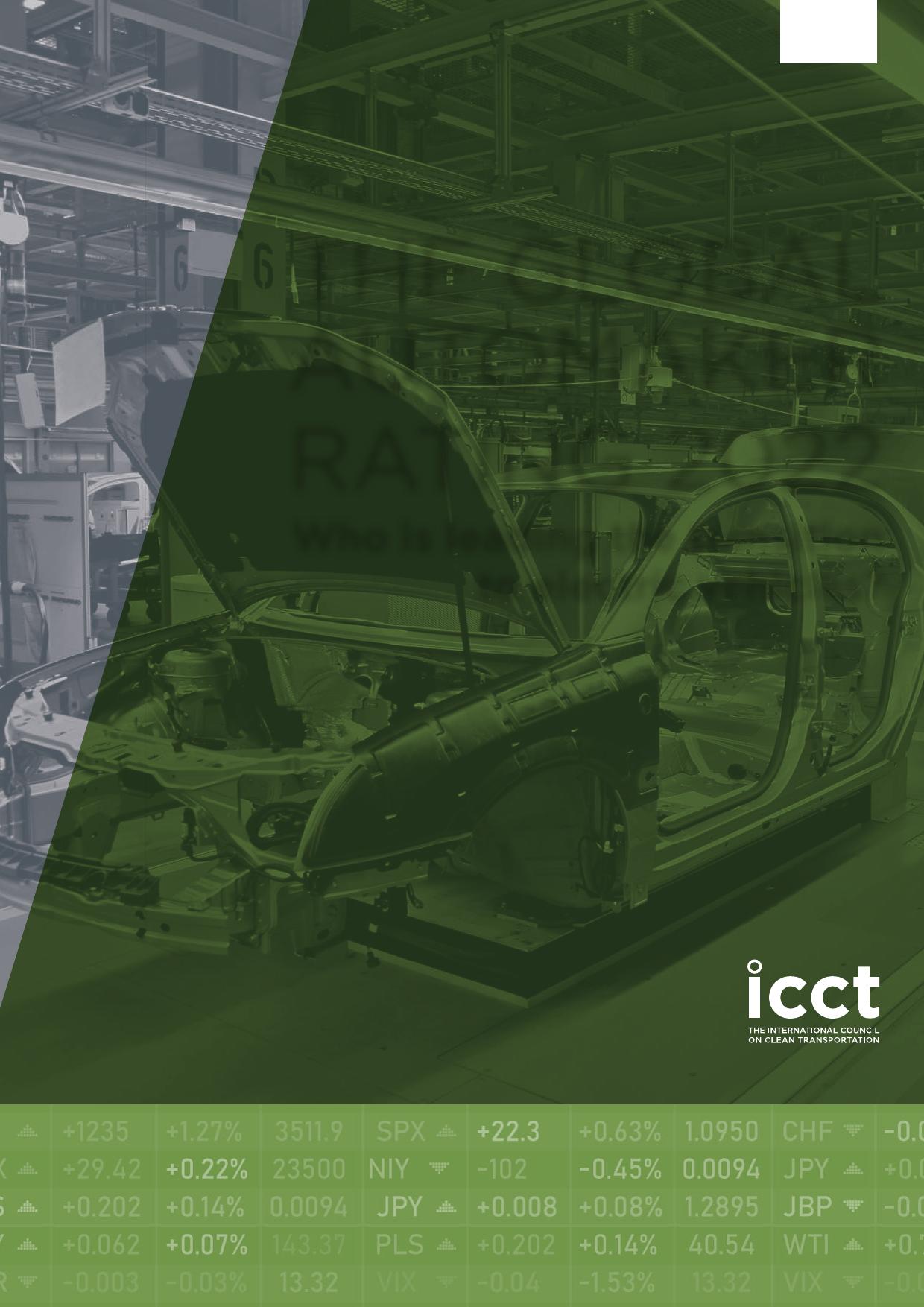2022THEGLOBALAUTOMAKERRATING2022Whoisleadingthetransitiontoelectricvehicles?ChangShen,IlmaFadhil,ZifeiYang,andStephanieSearleABOUTTHEICCTANDTHISREPORTTheICCTisanindependent,nonprofitorganizationthatprovidesfirst-rate,unbiasedresearchandpolicyanalysisoncleantransportationtogovernmentofficialsandotherrelevantstakeholdersfromcivilsocietyandindustry.Ourmissionistoimprovetheenvironmentalperformanceandenergyefficiencyofroad,marine,andairtransportationtobenefitpublichealthandmitigateclimatechange.TheICCTistheworld’sleadingresearchorganizationdedicatedsolelytocleanfuelandvehiclepoliciesandthedecarbonizationofthetransportsectorbymid-century.WhiletheICCTtypicallysupportsgovernmentpolicymakersandregulatorsastheydeveloppoliciestoreducetransportationemissions,thisreportisforawideraudience.Webelievethesameapproachweusetosupportgovernmentregulations—thatis,providingtimely,high-qualitydataandanalysistodecision-makers—canhelpinforminvestors,thebroaderfinancialsector,consumers,andautocompaniesatthiscriticaltimeintheindustry.Thisreportoffersanexpert,in-depthanalysisandcomparesglobalautomakersinthetransitiontozero-emissionvehicles.Ourassessmentmightbeofvaluetoinvestorsandratingcompanies.Consumersmightalsobeinterestedinknowinghowmuchefforteachautomakerismakingtotransitiontoafullydecarbonizedvehiclemarketandsupplychains.Andautocompaniesthemselves,allofwhichhavepledgedtoachievecarbonneutrality,mightfindadata-driven,transparentassessmentoftheiractionsandplansavaluableyardstickastheyworktofindopportunitiestoimprove.DISCLAIMERThisICCTreportisintendedforinformationalpurposesonly.AlthoughtheICCThasendeavoredtoorganizeandpresentdatafrommultiplethird-partysourcesinaneven-handedandneutralfashion,theselection,interpretation,weighting,andpresentationofthemetricsinthisratingreflectthesubjectiveassessmentsandopinionsoftheICCT.Additionally,whiletheICCThasreliedonlyondatasourcesitbelievestobereliableandhastakenstepstoverifysuchdatawithautomakers,andhasidentifieditssourcesintheinterestoftransparencyandverification,itcannotstatethatthedatacompiledandpublishedbyothersisaccurate.Thisreportshouldnotbeconstruedotherwise.ACKNOWLEDGMENTSWethankseveralcolleaguesforprovidingvaluablefeedback,includingICCTstaffmembersAmitBhatt,GeorgBieker,JenniferCallahan,MichaelDoerrer,HuiHe,AaronIsenstadt,IremKokKalayci,JoshMiller,PeterMock,RachelMuncrief,KelliPennington,FelipeRodríguez,DanRutherford,JoeSchultz,andPeterSlowik,andICCTboardmembersAnthonyEggert,MargoOge,GianniLópezRamírez,andMichaelWalsh.WearealsogratefulforfeedbackfromexpertreviewersCarstenHaink(independentsustainabilityconsultant),GaryRogers(CorvidTechnologies),KanchanKumarGandhi(CentreforAutoPolicy&Research),twoindividualsfromChinaEV100,PengfeiYangandYunyaoZhu(bothofChinaAutomotiveEngineeringResearchInstitute),andChrisMalinsandCatoSandford(bothofCerulogy).Finally,thankstotheAspenGlobalChangeInstituteforfinancialsupportofthiswork.Anyopinions,findings,andconclusionsorrecommendationsexpressedinthismaterialarethoseoftheauthorsanddonotnecessarilyreflecttheviewsoftheAspenGlobalChangeInstitute.InternationalCouncilonCleanTransportation1500KStreetNWSuite650WashingtonDC20005USAcommunications@theicct.orgwww.theicct.org@TheICCT©2023InternationalCouncilonCleanTransportationBTHEGLOBALAUTOMAKERRATING2022EXECUTIVESUMMARYThisreportrateshowtheworld’slargestautomanufacturersstackupinthetransitiontoelectricvehicles(EVs).Majormanufacturersarestrivingforfleetswithzerotailpipeemissions;successinthatisnecessaryfortheworldtomitigatetheworsteffectsofclimatechange.Toevaluatetheworkofmanufacturerstowardthatgoal,weratethemon10custom-builtmetricsthatreflectbothwhattheyaredoingnowandwhattheysaytheywilldointhenearfuture.Weevaluatetheircurrentfleetsandproductionprocessesandassesstheirstatedfutureplans,policies,andpriorities.Ourapproachisameaningfulandcomprehensivewaytodistinguishforward‑lookingautomakersfromtheirless-progressivecounterparts.Focusedonthetop20light-dutyvehiclemanufacturersintheworldbysalesin2022,thisreportaddsanimportantmissingpiecetoglobalresearchandanalysisregardinghowtoday’smajorautomakersaretransitioningtozero-emissionvehicles(ZEVs).Ourratingisquantitativeandtransparent;wepresentfulldetailsofourchosenmethodologyanddatasources.Additionally,theICCTcontactedalltheautomakersassessedinthisreporttoseektoverifythedatawecollected.Manyratingsreportsarevagueinemphasisandoftencoverthousandsofcompanieswithabroadenvironmental,social,andgovernance(ESG)lens.Thisreportisdifferent.Weuseourdeepexpertiseinthefieldtopresentafocused,incisiveratingthatcomparesautomakersinthistimeofunprecedentedtransformationintheindustry.Forexample,thisanalysisisbuiltonacomprehensivedatabasethatincludesbothsalesandkeyspecificationsofEVsinsixmajorvehiclemarkets.Thisreportalsoconsidersthereal-worldelectricdriveshareofplug-inhybridelectricvehicles(PHEVs).Becauseourratingincludesbothpresentandfutureperformanceindicators,wegroupour10metricsbythreepillars:marketdominance,technologyperformance,andstrategicvision.Theseserveasthebasisforouroverallratingresults.TableES1presentsthethreepillarscores;theoverall2022ratingsareintherightmostcolumn.Thisfinalscorereflectseachcompany’scomparativepositionintheZEVtransition.Theautomakersarelistedinorderfromhighesttolowestscoring.“Leaders,”showningreen,scoredinthetopthirdoftherating(66.7–100).“Transitioners,”inyellow,scoredinthemiddlethird(33.4–66.6).“Laggards,”inred,scoredinthebottomthird(0–33.3).iTHEGLOBALAUTOMAKERRATING2022TableES1.Overallscores,TheGlobalAutomakerRating2022TeslaMARKETTECHNOLOGYSTRATEGIC2022ratingLEADERSBYDDOMINANCEPERFORMANCEVISION83TRANSITIONERS736980100LAGGARDS567857835350BMW3178574847VW4963474545Stellantis4838634438Geely5551393838Renault43376136Mercedes-Benz3653473028GM2052632727SAIC652839100GreatWall434032Ford145544Hyundai-Kia355820Chang’an521341Toyota324315HondaNissan193232TataMazda331831Suzuki1541237418000ThemarketdominancepillarreflectstheprogressautomakershavemadeinthetransitiontoZEVsintheirownfleets(seeTableES2).Weanalyzeeachautomaker’sZEV-equivalentsalesshares,whichistheEVshareoftotallight-dutyvehiclesales,includingbattery-electricvehicles(BEVs),fuelcellelectricvehicles(FCEVs),andPHEVs.ForPHEVs,weassessonlytheshareofdrivingthatisonelectricitybyconsideringreal-worlddrivingbehavior.Wealsoassesstheshareofeightlight-dutyvehicleclasses,rangingfrommini/subcompactcartopick-uptruck,thatarecoveredbyavailableZEVmodelsfromeachautomaker.Theleadersinthemarketdominancepillar,TeslaandBYD,alreadyproduceonlyEVs.TeslaonlyproducesBEVs,andinMarch2022,BYDshiftedtoonlymanufactureEVs(i.e.,bothBEVsandPHEVs).AllotherautomakerslagsignificantlyinZEVsalesshares,althoughsomesucceedinofferingcoverageacrossalleightlight-dutyvehicleclasses.iiTHEGLOBALAUTOMAKERRATING2022TableES2.RatingsonmarketdominanceMARKETDOMINANCEBYDZEV-equivalentClasscoveragePillarscoreTeslasalesshare(0-100)(0-100)(0-100)SAIC698878Geely100LEADERSChang’an38VW3169Stellantis23Renault1610065GreatWall10Mercedes-Benz88855Hyundai-Kia11108852Nissan10Toyota88849BMWGM48848TRANSITIONERSHonda1Tata127543Ford2Mazda07543Suzuki64633610633563336332503138203819LAGGARDS2515251413700Thetechnologyperformancepillarratestheautomakers’levelsoftechnologicaladvancementinmeetingconsumerneedsandreducingupstreamemissions.Inthispillar,weratefivemetrics.Onvehicleperformance,theenergyconsumptionmetricanalyzesthepotentialforBEVstolowerelectricitycostsforconsumersandreducethecostandenvironmentalimpactsofmakingbatteries;chargingspeedassesseshowquicklyaBEVcanrechargeitsbattery;anddrivingrangereflectshowfaraZEVcantravelbeforerechargingorrefuelingasanimportantelementofconvenienceforconsumers.Ontheupstreamemissions,therenewableenergymetricanalyzeshowmuchprogressanautomakerhasmadeinswitchingto100%renewableelectricityinvehicleproductionandassemblyandbatterymanufacturing.ThebatteryrecyclingandrepurposingmetricassesseshowmuchprogressanautomakerhasmadeinstartingtorecycleandreusebatteriesfromitsEVs(seeTableES3).MostautomakersaremakingprogressinvehicletechnologyandscorehighlyinatleastoneofthetechnologicalattributesthatwillleadtogreaterconsumersatisfactionwithiiiTHEGLOBALAUTOMAKERRATING2022andacceptanceofZEVs.Thisisclearlyapriorityforautomakers.However,thereisalongwaytogoinsustainablevehiclemanufacturing.OnlyBMW,VW,andMercedes-Benzhavemadestrongprogressinusing100%renewableelectricity.Althoughsomeautomakersshowstrongerprogressonbatteryrecyclingandrepurposingthanothers,allneedtoexpandinthisareafortheirfuturesupplychainstobesustainable.Tothriveinazero-carbonfuture,mostautomakerswillneedtosurpassthecurrentbestperformerinthemarket.TableES3.RatingsontechnologyperformanceTECHNOLOGYPERFORMANCETeslaEnergyChargingDrivingRenewableBatteryPillarscoreBMWconsumptionspeedrangeenergyrecycle/(0-100)(0-100)(0-100)(0-100)repurpose(0-100)(0-100)801001000LEADERS1001005276100787292VW605182754963Hyundai-Kia3275731110058BYD743873010057Ford264995149155Mercedes-Benz554173504353GM53317809952Geely51TRANSITIONERS4532689100Toyota43357065943Tata8732168741GreatWall551530010040Stellantis28362809838Renault49133209037Honda51265203232SAIC490009028Nissan19122903118Chang’an13LAGGARDS4541900Mazda0193004SuzukiN/AN/AN/A000ThestrategicvisionpillarrateshowfocusedautomakersareonZEVsintheirlonger-termplanningbythreemetrics(seeTableES4).TheZEVtargetmetricanalyzestheextenttowhichautomakershavesetlong-termtargetsforZEVsalesshareconsistentwithwhatisneededtokeepglobalwarmingbelow2°C.TheZEVinvestmentmetricassessesthetotalannouncedinvestmentinZEVresearchanddevelopment(R&D),ivTHEGLOBALAUTOMAKERRATING2022ZEVandbatterymanufacturingsites,andinfrastructure,relativetothesizeofanautomaker.Andfinally,theexecutivecompensationmetricexaminesthedegreetowhicheachautomaker’stopexecutive’spayistiedtoprogressinEVdevelopment.ManyautomakersarecommittedtoZEVs.Indeed,ninehavecommittedtoafulltransitiontoZEVsintheleadingvehiclemarketsby2035foratleastonebrand;nearlyallhaveannouncedmajorinvestmentsinZEVdevelopment.However,fewautomakersleverageexecutivepay.SomelinkexecutivecompensationbroadlytoESGperformance.Onlyfive(Stellantis,BMW,GM,Renault,andNissan)tiethepayoftheirtopexecutivedirectlytoprogressinEVdevelopmentforevenafractionofthecompensationpackage.CompaniesstrivingtocatchupinthetransitiontoZEVsshouldconsiderusingthispotentiallypowerfultool.TableES4.RatingsonstrategicvisionSTRATEGICVISIONTeslaZEVtargetZEVinvestmentExecutivePillarscoreBYD(0-100)(0-100)compensation(0-100)100GM70100(0-100)100StellantisLEADERSRenault9679100BMW8183Mercedes-Benz100100VW7263Ford96365763Chang’an9261SAIC96910057Geely6847374537GreatWall71TRANSITIONERSHonda208047Nissan9244Tata73341241Hyundai-Kia6039Mazda52232639Toyota39Suzuki3036032393205603123810LAGGARDS4602018501502402471802002507000vTHEGLOBALAUTOMAKERRATING2022Fromouroverallratingfor2022,wedrawthreebroadconclusions:Mostautomakersscorewellonatleastonemetric.ThisreflectsthecomplexityandbreadthoftheZEVtransition,aswellasdifferingapproachesfromautomakers.Oftheautomakersthatleadthe2022rating,Teslaismaking100%ZEVsandBYD’smarketshareforZEVsandPHEVshasreached99%.Someautomakers,includingChang’an,Geely,SAIC,Stellantis,andVW,aredevelopingawiderspectrumoflight-dutyZEVmodelsfromsmallcarstosmalltrucks.Some,includingBMW,Ford,GM,Hyundai-Kia,Mercedes-Benz,andVW,havefocusedonimprovingsomeofthetechnologicalattributesimportanttoconsumers.BMW,VW,andMercedes-Benzarealsoworkingtoreducetheirupstreammanufacturingemissions.ManyautomakershaveestablishedZEVtargetsandareinvestingtomeetthosetargets.Byratingmanufacturersonabroadsetofmetrics,ouranalysisoffersasharp,balancedviewoftheirstrengthsandweaknesses.Everyautomakerhasworktodo.EvenTesla’sandBYD’sratingswereweakonsomemetrics.Forexample,ourratingshowsthatTeslaneedstooffermoremodelsacrossthesizespectrum.In2022,Teslaofferedmodelsinonlythreeoutofeightvehicleclassesweidentified.Similarly,BYDhasworktodotoimprovethetechnologicalattributesimportanttoconsumers.Asthetransitionaccelerates,allcompaniesmustevolveandgrowtokeeppacewiththechangingmarket.ManufacturersheadquarteredinJapanandIndiamustworktocatchuptocompetitorsinthetransition.AllfivemanufacturersheadquarteredinJapanandTata,headquarteredinIndia,areatthebottomofourrating.Toimprove,theyneedtoincreasetheirEVsales,setpublicZEVtargets,andinvestinZEVs.Itisthecase,though,thatintheabsenceofeffectivegovernmentpolicies,thedomesticmarketsforEVsinJapanandIndiaareanemicatpresent.However,thesecompanieswouldhaveratedhigheriftheyhadannouncedstrongertargetsandinvestmentplansfortheZEVtransition.Wewillupdatethisratingreportannually.Itwillundoubtedlyevolveeachyearasthelandscapeevolvesandasautomakersmakeprogress.Ourreviewwillremaindata-drivenandwillincorporatenewreal-worlddataonZEVsasitbecomesavailable.Wewillcontinuallyupdateourmetricsasnewpracticesemergeandexistingpracticesmature,forexamplebyincorporatingadditionalelementsofsupplychaindecarbonization.Inoursubsequentreports,wewillcontinuetotrackautomakers’progressinthecomplex,multi-facetedZEVtransition.Inthemeantime,thisreportoffersthedefinitivelookathowglobalautomakersrateinthetransitiontoZEVs.viTHEGLOBALAUTOMAKERRATING2022TABLEOFCONTENTSEXECUTIVESUMMARY................................................................................................................i1INTRODUCTION...................................................................................................................12RATINGFRAMEWORK.......................................................................................................32.1Scopeoftherating........................................................................................................................32.2Evaluationstructure.......................................................................................................................52.3Datasourcesandprocess...........................................................................................................63MARKETDOMINANCE......................................................................................................103.1ZEV-equivalentsalesshare.......................................................................................................103.2Classcoverage................................................................................................................................124TECHNOLOGYPERFORMANCE........................................................................................164.1Energyconsumption....................................................................................................................164.2Chargingspeed..............................................................................................................................184.3Drivingrange...................................................................................................................................214.4Renewableenergyinmanufacturing....................................................................................234.5Batteryrecyclingandrepurposing........................................................................................265STRATEGICVISION............................................................................................................315.1ZEVtarget........................................................................................................................................315.2ZEVinvestment.............................................................................................................................345.3Executivecompensationalignment......................................................................................386FINALRATINGRESULTSANDDISCUSSION..................................................................427CONCLUSIONS...................................................................................................................47REFERENCES.............................................................................................................................48APPENDIXA.Dataprocessingandsources..........................................................................50APPENDIXB.Supplementarydataformetricscoring........................................................53B.1ZEV-equivalentsalesshare.......................................................................................................53B.2Energyconsumption...................................................................................................................54B.3Chargingspeed.............................................................................................................................55B.4ZEVinvestment.............................................................................................................................56APPENDIXC.Methodologydetails........................................................................................57C.1Real-worldelectricdriveshareestimation.........................................................................57C.2ClasscoveragecategorizationusingICEV-equivalentcurbweight........................58C.3Energyconsumptionadjustment..........................................................................................60C.4Chargerdefinitions........................................................................................................................61viiTHEGLOBALAUTOMAKERRATING20221INTRODUCTIONMeetingthegoalssetintheParisClimateAgreementwillrequireanunprecedentedtransitionintheautoindustryawayfrominternalcombustionenginevehicles(ICEVs)tozero-emissionvehicles(ZEVs).Automakersaroundtheworldwillneedtotransitioninthenextdecadetokeepupasgovernmentpoliciesalignwithclimategoalsandasmarketforcesandconsumerpreferencespushinthisdirection.Thischangingrealityisalreadyreflectedinnewvehiclesales.Theshareofelectricvehicles(EVs)—thistermcoversbatteryelectricvehicles(BEVs),plug-inhybridelectricvehicles(PHEVs),andfuelcellelectricvehicles(FCEVs)—hasbeengrowingrapidlyinleadingmarkets.In2022,China,Europe,andtheUnitedStatesreached24%,21%,and7%EVshareofnewsales,respectively,forlight-dutyvehicles(LDVs),whichincludecars,vans,andlightcommercialvehiclessuchaspick-uptrucks.Thesemarketscomprisedaround60%ofglobalLDVsaleslastyearandaretheleadersinvehiclepolicy.AutomakersthathavealreadysettargetstophaseouttheproductionofICEVsaccountedfor40%ofLDVsalesin2022.Itnowseemsthat,withintheforeseeablefuture,mostnewcar,van,andpick-uptrucksaleswillbeEVs.Forautomakersacceleratingeffortstotransition,thisisabigopportunity.Atthesametime,thoseunabletokeeppaceintheindustry’stransformationfaceabigrisk.ThisreportfocusesprimarilyonZEVs,whicharedefinedasBEVsandFCEVs,andweincludeelementsthatreflecttheimportanceofmovingtowardzero-carbonmanufacturingsupplychains.PHEVsincorporateelectricdrivetraintechnology,butreal-worlddatashowstheyoperatemostlyongasoline;becausetheygeneratetailpipeemissionsfromcombustingfossilfuels,wediscountPHEVsinouranalysis.Additionally,weexcludevehiclesthatrunonbiofuelsande-fuelsfromouranalysis,becausepreviousICCTresearchdemonstratedthatthereisnorealisticpathwayforusingalternativefuelstodecarbonizeICEVs.Mostconventionalbiofuelsusedtodaydonotclearlyreducegreenhousegas(GHG)emissionscomparedtodieselandgasoline.Whileadvancedbiofuelsmadefromwastesaremoresustainable,theyareexpensivetoproduceandthenecessaryfeedstocksarelimited.Usinge-fuelsininternalcombustionenginesisanextraordinarilyinefficientandexpensivewaytouserenewableelectricity.OnlyBEVsandFCEVsusing100%renewableenergyarerealisticZEVpathways,asdiscussedinSearleetal.(2021).Byourestimate,ZEVsaleswillneedtoreachalmost100%forLDVsinthemajormarketsby2035—andmeetaninterimtargetof77%in2030—toalignwitha2°Cclimatetrajectory;additionalmeasureswillbeneededtoalignwitha1.5°Cpathway(Sen&Miller,2022).Whiletherearemanypublishedassessmentsofautocompanies,thisratingisuniqueamongpubliclyavailablereportsinitsglobalscopeandfocusonatransitiontoazero-emissionfuturefortheindustry,ratherthanonbroadenvironmental,social,andgovernance(ESG)criteria.Additionally,thisratingisbasedprimarilyonourowncollecteddataandanalysis,ratherthanoncorporatesurveysandotherself-reportedinformation.WedrawonICCT’sin-depthknowledgeoftheindustry,majormarkets,andwhatisrequiredtoalignwiththeParisAgreement.Ourapproachisbolsteredwithsupplementalinputandinsightsfromotherexpertsinahandfulofkeyareas.Weuse10custom-builtmetricstoidentifyandevaluateeffortsbytheworld’s20largestLDVmanufacturersbysalestodecarbonizetheirvehiclefleetsandmanufacturingoperationsconsistentwithlimitingglobalwarmingtobelow2°C.Weexamineeachmanufacturer’slatestZEVsales,actionstoreducemanufacturingemissions,andoverallstrategiesaskeyindicatorsoftheircommitment.Thefinalratingresultsareaself-consistentviewofthecurrentstateoftheZEVtransition.1THEGLOBALAUTOMAKERRATING20222RATINGFRAMEWORK2THEGLOBALAUTOMAKERRATING20222RATINGFRAMEWORK2.1ScopeoftheratingThisratingfocusesontheproductionandsaleofLDVs.ItsanalysisisbasedondatadevelopedforautomanufacturersinthesixlargestLDVmarketsin2022:China,theUnitedStates,Europe,Japan,India,andtheRepublicofKorea.ThesearethetopfivemarketsintermsofLDVsalesin2022andKorea,whichwastheseventhlargestinsalesandthefifthlargestintermsofvehicleproduction.Thesesixmarketstogetherhaveaccountedforabout73%ofglobalLDVsalesinrecentyears(MarkLines,2023).Weselectedthetop20automanufacturersintheworldbasedontheirglobal2022LDVsales.Forthisrating,manufacturermeansthecontrollingcorporateentity.Anentitymightcontrolmultipleautomotivebrands.ForjointventuresinChina,manufacturersheadquarteredoutsideofChinacollaboratewithaChina-headquarteredcounterpartunderatechnology-sharingagreement;inthesecases,wedistinguishbetweenvehiclesthataremanufacturedundernon-domesticordomesticbrandsandthencountthecorrespondingsalestowardthenon-domesticordomesticcontrollingcorporateentityaccordingly.Figure1showsthetop20manufacturersandtheir2022globalLDVsales,withcolor-codingrepresentingsalesinthesixmajorregionsandanadditionalcategoryforsalesintherestoftheworld.Thesemanufacturerswereabout90%ofallLDVsalesinthesixmajormarkets;theirsalesinthesesixmarketswerethevastmajorityoftheirglobalLDVsales.Theregionaftereachautomaker’snameindicatesthelocationwhereitisheadquartered.FiveareheadquarteredinChina,fiveinJapan,fiveinEurope,threeintheUnitedStates,oneintheRepublicofKorea,andoneinIndia.Mostofthe20manufacturerssellinmultipleregions.3THEGLOBALAUTOMAKERRATING2022ToyotaJapanChinaVWEuropeUnitedStatesEuropeHyundai-KiaKoreaJapanStellantisEuropeIndiaGMU.S.KoreaHondaJapanOtherFordU.S.NissanJapan2,000,0004,000,0006,000,0008,000,00010,000,000SuzukiJapanBMWEuropeRenaultEuropeMercedes-BenzEuropeSAICChinaGeelyChinaChang’anChinaBYDChinaTeslaU.S.GreatWallChinaMazdaJapanTataIndia(NameHeadquarters)0Figure1.2022light-dutyvehiclesalesbythetop20manufacturersinthesixmajormarkets.Weevaluatemanufacturersbasedontheirsales,actions,andstrategiesinthesixmajormarkets.Vehicle-relatedanalysesarebasedonnewlight-dutysalesin2022;forward-lookingstrategyandactions-relatedanalysesarebasedoninformationcollectedthroughtheendof2022.11Someinformationwascollectedin2023,toverifythefeedbackwereceivedfromautomakers;nonetheless,allinformationreflectsthestateoftheautomakersonlythrough2022.4THEGLOBALAUTOMAKERRATING20222.2EvaluationstructureWedesignedtheratingaroundthreepillars,eachmadeupofdifferentmetrics.Thereare10metricsintotal.Together,theyreflectthelatesteffortstowardandpotentialforafullZEVtransition.Figure2providesanoverviewofthethreepillars(marketdominance,technologyperformance,andstrategicvision)and10metrics.Theareaforeachmetricinthefigurerepresentsitscontributiontothefinalrating.ZEV-equivalentEnergyconsumptionsalesshareChargingspeedANCETECHPDrivingrangeNMARKETDOMIERFORMANCEZEVclassRenewableenergycoverageinmanufacturingSTRATEGICVISIONBatteryrecyclingandrepurposingZEVtargetExecutivecompensationalignmentZEVinvestmentFigure2.OverviewofthestructureofICCT’sGlobalAutoRating.MarketdominancereflectstheprogresseachmanufacturerhasmadeinitstransitiontoZEVs.Itconsistsoftwometrics:•ZEV-equivalentsalesshareisthefractionofeachmanufacturer’sLDVsalesthatareBEVs,FCEVs,andPHEVs.EachPHEVwasdiscountedasapercentageofaZEVbasedonthereal-worldelectricdriveshareofPHEVs,estimatedfromrecentstudies.•ZEVclasscoveragereflectstheshareofeightLDVclasses,rangingfrommini/subcompactcartolighttruck,thatarecoveredbymodelofferingsfromeachmanufacturer.Technologyperformanceconsistsoffivemetrics,threeimportanttoconsumerexperienceandtwoconcernedwithreducingupstreamemissions,whichisanimportantpartofdecarbonizingtheautomotiveindustry.Theyare:•Energyconsumptionisthesales-weightedaverageofcertifiedenergyconsumptionofBEVssoldbyeachmanufacturer,normalizedtothesametestcycleandinwatt-hoursperkilometer(Wh/km).•ChargingspeedisthemaximumaveragechargingspeedofBEVssoldbyamanufacturer,inkilowatts(kW).•Drivingrangeisthesales-weightedaverageofcertifieddrivingrangeofZEVssoldbyamanufacturer,normalizedtothesametestcycleandinkilometers(km).5THEGLOBALAUTOMAKERRATING2022•Renewableenergyinmanufacturingreflectseffortsanautomakerhasmadetomoveto100%renewableelectricityinvehicleassemblyandbatterymanufacturing.•Batteryrecyclingandrepurposingreflectswhethermanufacturershavebegunpilotprojectsorcollaborationsinbatteryrecyclingandreuse.StrategicvisionreflectsthevisionandcommitmentofeachmanufacturerintheZEVtransition.Itconsistsofthreemetrics:•ZEVtargetisbasedoneachcompany’sstatedZEVsalessharetargetsanddates,andtheirdegreeofalignmentwiththeZEVsalessharesneededtokeepglobalwarmingbelow2°C.•ZEVinvestmentincludestotalannouncedinvestmentinZEVandbatteryproductionsites,charginginfrastructure,andZEVresearchanddevelopment(R&D),relativetoanautomaker’ssize.•Executivecompensationalignmentreflectstheextenttowhichanautomaker’stopexecutive’spayistiedtoEVdevelopment.Weawardmanufacturerspointsaccordingtotheirperformanceoneachmetric.Thehighestpossiblescoreineachmetricis100;thelowestiszero.Althoughsomemetricshavetheabsolutebestandworstperformancebynature,suchasaZEVsalesshareof100%(best)and0%(worst),metricslikeenergyconsumption,chargingspeed,anddrivingrangehavenonaturalabsolutebestorworst.Therefore,tocreateanevaluationmechanismthatappliesthesametoallmetrics,wesetthebottomscoretozeroandassignedthetopperformerforeachmetricascoreof100.WeappliedEquation(1),below,tocalculatethefinalscoreforeachmanufacturerforeachmetric:Metricscore(0to100scale)=Points-Pointsmin×100(1)Pointsmax-PointsminWherePointsisthenumberofpointsforthemetricforagivenmanufacturer;Pointsministhelowestnumberofpointsacrossallmanufacturers;andPointsmaxisthehighestnumberofpointsamongallmanufacturers.Scoresarecalculatedforeachofthethreepillarsandeachpillarscoreiscalculatedastheaverageofthemetricscoreswithinthatpillar.Ifanautomakerhas“N/A”forametric,weaveragethescoresoftheothermetricstogetthepillarscore.2Thefinalratingiscalculatedastheaverageofthethreepillarscores.Whileallaveragesaredonewithoutrounding,theresultsreportedareroundedtothenearestinteger.Weassignthesameweighttothethreepillarsinthefinalrating,becausetheyareequallyimportant.Becausetherearedifferentnumbersofmetricswithineachpillar,thecomparativeweightingofindividualmetricsisthesamewithineachpillar,butdifferentfromtheindividualmetricsinotherpillars.Thisisinherentinthedesignofourevaluation.2.3DatasourcesandprocessFiveofthemetricsassessedinthisratingareatthevehiclelevelandtheotherfiveareatthemanufacturerlevel.Vehicle-levelmetricsareZEV-equivalentsalesshare,ZEVclasscoverage,energyconsumption,chargingspeed,anddrivingrange.2SuzukigotN/Afortheenergyconsumption,chargingspeed,anddrivingrangemetrics,becauseitdidnotsellanyZEVsin2022.ItwastheonlyautomakertoreceiveN/Aforanymetric.6THEGLOBALAUTOMAKERRATING2022Manufacturer-levelmetricsareZEVtarget,ZEVinvestment,executivecompensationalignment,renewableenergyinmanufacturing,andbatteryrecycling.Datasourcesaredescribedbelow.Forvehicle-leveldata,wedevelopedadatabasethatincludesallnewLDVssoldin2022bythemanufacturersinthesixvehiclemarkets.Weobtainedvehicledatafrommultiplesalesdatabasestomaximizedatacoverageandaccuracy.Dataregardingvehiclesalesandvehiclepowertraintypewerederivedfromfoursourcesfornewvehiclessoldin2022.ThisincludesU.S.,Korea,andJapandatafromMarkLines(MarkLines,2022);EuropedatafromDataforce(Dataforce,2022),includingvehiclesalesintheEuropeanUnion,EFTA(EuropeanFreeTradeAssociation)memberstates,andtheUnitedKingdom;IndiadatafromSegmentY(SegmentY,2022);andChinadatafromZEDATA(ZEDATA,2022).Dataonthespecifications(grossweightandcurbweight,grossandnetbatterycapacity,energyconsumption,drivingrange,andchargingtime)ofeachmodelwerecollectedfromspecificationbrochuresonmanufacturers’officialwebsitesandfrommajorEVinformationhubsincludingev-database.org,evspecifications.com,andev-volumes.comforEuropeanandU.S.models,andyiche.comandautohome.comforChinesemodels.Variationsinthelevelofdetailandfocus,includingthingslikeincludeddatafields,amongthevariousdatasetsrequiredsubstantialprocessingtodevelopacomprehensivesetofgloballyconsistentdata.AppendixAdescribesthemethodologybehindthecreationofthisdatabase.Formanufacturer-specificactions,informationaboutZEVtargets,useofrenewableenergyinmanufacturing,andbatteryrecyclingandrepurposingwasprimarilysourcedfromthemanufacturers’latestannualsustainabilityreports.3Thiswassupplementedwithpressreleases,mediaarticles,andpublicannouncementscollectedthroughtheendof2022,tocaptureanydevelopmentsbetweenwhenthesustainabilityreportwaspublishedandtheendoftheyear.Someautomakersprovidedfeedbacktoourinputinformationbyreferringtotheirsustainabilityreportspublishedin2023.Weincorporatedthatinformationintothisratingaslongasitreflectedtheautomakers’effortsin2022.Thedatausedtoassessmanufacturers’investmentsinZEVswasobtainedfromAtlasPublicPolicy’sEVHub(AtlasPublicPolicy,2022).Theinformationregardingthemechanismbehindandtheelementsusedindeterminingthecompensationforeachcompany’schiefexecutivewascompiledbyValensResearchspecificallyforthisrating.Theinformationwasextractedfromtheproxystatementsandotherpublicfilingsofeachmanufacturer.Detailedinformationonthedatasourcesisinthemethodologysectionforeachindividualmetric.ThecompletelistofannualsustainabilityreportsandsupplementarysourcesreviewedforthisanalysisisinAppendixA.Mostofthetop20manufacturersoperateinmultiplemajormarkets,andpracticesandambitionscandifferacrossregions.Forexample,somemanufacturershaveadopted100%renewableelectricityinmanufacturinginEurope,butnotinotherregions.ThesamemanufacturermightalsoannouncedifferentZEVtargetsandICEVphase-outdatesforEurope,theUnitedStates,andtheotherregions.Toaccountforsuchdifferences,wecollectedmanufacturers’globalandregionalstrategiesandimplementationactionsfromthesourcesdescribedabove.Wheneverthereweredivergencesinregionalpractices,wecalculatedtheglobalaverageperformancemetricsweightedbythevehiclesalesinthecorrespondingregionalmarkets.3Sometimesannualsustainabilityreportswereidentifiedbythecompaniesasanenvironmentalreport,climatereport,orESGreport.Forsimplicity,werefertoalloftheseas“annualsustainabilityreport”throughoutthisreport.7THEGLOBALAUTOMAKERRATING2022Additionally,somesubsidiarymarqueshaveseparatesustainabilityreportsthatsetdifferentgoalsfromtheparentcompany.Forexample,VolvohasseparatesustainabilityreportsanddifferentZEVtargetsthanitsparentcompany,Geely.Inthiscase,wecollectedinformationaboutstrategiesandimplementationforboththesubsidiarycompanyandtheparentcompanyandcalculatedtheaverageperformancemetricsweightedbythesalesofthedifferentmarques.Toensuretheaccuracyandtimelinessofthemanufacturer-specificinformationusedforthisrating,weaskedall20automakerstoreviewtheinputdataandinformationusedforevaluatingmanufacturer-specificactionsandcommitments.Wedidnotdisclosetheevaluationframeworkorevaluationmethodologyinourcommunicationwithautomakers.Wereceivedfeedbackfrom11automakers:BMW,BYD,Ford,GM,GreatWall,Mercedes-Benz,Renault,Stellantis,Tata,Tesla,andVW.Whenautomakersdisagreedwithourinformation,theygenerallyprovidedrevisedorupdateddatawithorwithoutcitingsources.Wereinvestigatedtoverifyallinformationbeforeusingitfortheanalysis.Thefinalmanufacturer-specificinformationappliestotheevaluationoffivemetrics:renewableenergyuse,batteryrecyclingandrepurposing,ZEVtarget,ZEVinvestment,andexecutivecompensationstructure.Theanalysisoftheotherfivemetricswasbasedonvehicle-specificdatafromeitherproprietarydatasourcesoropensources;wedidnotaskautomakersforfeedbackonthatdata.8THEGLOBALAUTOMAKERRATING20223MARKETDOMINANCE9THEGLOBALAUTOMAKERRATING20223MARKETDOMINANCE3.1ZEV-equivalentsalesshareTheZEV-equivalentsalesshare,whichrepresentstheshareofanautomaker’stotalLDVsalesthatareZEVs,isthemostdirectmeasureofprogressintheZEVtransition.TheZEV-equivalentsalesshareisthesumofamanufacturer’sZEVshareandthediscountedPHEVshare.ZEVsareBEVswithnoadditionalpowersourceorFCEVs.PHEVsarehybridvehiclesequippedwithaninternalcombustionengine,anelectricmotor,andabatterythatcanbechargedexternally.TheyareconsideredpartialZEVsbecausetheycanbedrivenforaperiodwithzerotailpipecarbondioxide(CO2)emissions.ThediscountfactorsforPHEVsinthisevaluationarebasedonreal-worldstatistics.Ideally,theZEV-equivalentsalessharewouldbe100%,indicatingthatamanufacturerproducesandsellsonlyZEVs.METHODOLOGYVehiclesalesdataisfromthecompiledvehiclesalesdatabaseexplainedinSection2.3,whichreflectsallnewLDVssoldinthesixmajormarketsin2022.WhileeachBEVorFCEVsoldcountsasoneZEV,wediscountaportionofPHEVsalesusingafactorbasedonreal-worldelectricdriveshare(i.e.,theportionofkilometersdrivenonelectricity).Thediscountfactorsreflectthenon-electricdrivingshare.Recentresearchestimatedthatthereal-worldelectricdriveshareofPHEVsintheUnitedStatesis25–56%lowerthanwhatisindicatedintheU.S.EnvironmentalProtectionAgency’s(EPA)labelingprogram(Isenstadtetal.,2022).Studiesalsofoundlowerreal-worldelectricdriveshareinEuropeandChina(Plötzetal.,2020;Plötzetal.,2022).Usingthereal-worldelectricdrivesharetodiscountPHEVsalessharebetterreflectsthemorelimitedclimatebenefitsPHEVsdelivercomparedtoBEVsandFCEVs.ThePHEVdiscountfactordependsontheelectricdrivingrangeofthemodel.Real-worlddatashowsthat,ingeneral,thelongertheall-electricrangeofaPHEV,thelargertheshareofall-electric,zero-tailpipe-emissionsdriving.ForeachPHEVmodel,thediscountfactorweapplytodeterminetheZEV-equivalentshareiscalculatedbyanequationthatrelatesamodel’scharge-depletingrangetoitsreal-worldelectricdriveshare.DetailsofthiscalculationarepresentedinAppendixC.1.(ThesourcesofPHEVcharge-depletingrangedataweredescribedinSection2.3.)ThediscountfactorsforPHEVmodelsrangefrom28%–94%;thesales-weightedaverageis68%.ThetotalZEV-equivalentsalesshareisthesumoftheZEVshareandthediscountedPHEVshare,rangingfrom0%–100%.ThemanufacturerwiththehighestZEV-equivalentsalessharereceivesascoreof100.ThemanufacturerwiththelowestZEV-equivalentsalessharereceivesascoreofzero.Othermanufacturersarescoredbasedontheirrelativemetricpointscomparedwiththebestandworstperformersandreceiveascorebetweenzeroand100(seeEquation[1]).RESULTSAsexpected,therewerelargevariationsinmanufacturersalessharesin2022.Somelegacymanufacturers(i.e.,manufacturersthathavebeenproducingICEVs),includingBYDandSAIC,havemadenoticeableadvancesinbringingZEVstomarket.Figure3summarizesthevehiclesalessharesofLDVsbymanufacturerin2022.Ontherightsideofthefigure,thebluebarsindicatethesalesshareofBEVsandFCEVs.Theyellow10THEGLOBALAUTOMAKERRATING2022bars,includingthepartwithapattern,indicatetheactualPHEVsalesshare.ThesolidyellowbarsindicatethediscountedPHEVsalesshareafteraccountingfortheirreal-worldelectricdriveshare.Ontheleftsideofthefigure,thegreybarsindicatesalesofICEVs.Thefinalratingsofthismetricforeachautomakerarelistedtotherightofthebars.DetailsoftheZEVandPHEVsalessharesbymanufactureranddetailsoftheZEV-equivalentsharesacrossthesixmajormarketsarepresentedinTableB1inAppendixB.InternalcombustionenginevehiclesZEV-equivalentsalesshare(ICEVs)salesshare100%0%50%100%50%100(Score)Tesla69BYD1631PHEVsSAIC12shareofPlug-inGeely1123drivinghybridChang’an10onelectricBMW10Battery-electricityvehiclesRenault10andfuel(PHEVs)GreatWall8cell-electricMercedes-Benz8vehiclesVW6(ZEVs)Stellantis4Hyundai-Kia4Tata2Nissan1Ford10GM0MazdaToyotaHondaSuzukiFigure3.ZEVandPHEVsalessharebymanufacturerin2022andratingfortheZEV-equivalentsalessharemetric.Mostmanufacturers’ZEV-equivalentsalesaredrivenbyBEVsales.BYDistheonlymanufacturerwithaconsiderablePHEVshare(49%).FCEVsaleswereminimal,0.2%ofallZEVsalesbyall20manufacturers;97%ofthosesaleswerebyHyundai-KiaandToyota;theremainingsalesweresplitbetweenHonda,SAIC,andBMW.Teslaleadsonthismetricwitha100%ZEV-equivalentsalesshare,becauseitonlyproducesBEVs.BYD,whichmadethetransitiontoonlyproducingBEVsandPHEVsinMarch2022,followscloselywitha69%ZEV-equivalentsalesshare.TheotherfourmanufacturersheadquarteredinChinahaveZEV-equivalentsharesrangingfrom10%–31%,withmostsalescomingfromtheChinesemarket.Geely’shighZEV-equivalentshareinEuropeisfromitsVolvosubsidiary.ManufacturersheadquarteredinEuropehaveZEV-equivalentsharesbetween8–12%andhavesignificantlyhigherZEV-equivalentsalessharesinEuropethaninothermarkets.ThetwomanufacturersheadquarteredintheUnitedStates,FordandGM,haverelativelylowZEV-equivalentshares,eachbelow5%.ManufacturersheadquarteredinJapanalsoperformedpoorlyinthismetric,withZEV-equivalentsharesrangingfrom0.03%–4%.SuzukireceivedascoreofzerobecauseithasthelowestZEV-equivalentsales,acombinationofzeroZEVsalesandaPHEVsalesshareof0.1%.11THEGLOBALAUTOMAKERRATING20223.2ClasscoverageAutomakersoftensellavarietyofmodelsacrossmanyvehicleclassesorsegmentstoattractabroadrangeofcustomers.Consumersusevehiclestomeetavarietyofneeds.Theirrequirementswhenselectingavehicleforpurchasethusvary;becauseofthis,theyneedavarietyofmodelsfromwhichtochoose.TheclasscoveragemetricevaluatestherangeanddiversityofBEVandFCEVmodelsofferedbymanufacturersandhowwelltheycatertodifferentmarketsegments.Manufacturerswithbroaderclasscoveragehaveinvestedinvehicletechnologyandproductionplatformstoservedifferentsubmarkets.Thiswiderrangeofcoveragecouldgivemanufacturersanadvantagewhentheyseektogrow,becausetheywillhaveaccesstoalargercustomerbase.HavingavarietyofZEVmodelsforsalealsosupportstheoveralltransition,asitincreasesconsumerchoice.Asthismetricreflectsmanufacturers’effortstowardazero-tailpipe-emissionsfuture,PHEVmodelsareexcluded.METHODOLOGYThereisnouniversaldefinitionforvehicleclasses.Consequently,combiningdatafrommajorvehiclemarketsresultsinmyriadinconsistentvehicleclassifications.Toaddressthis,weuseasimplifiedclassificationsystembasedonvehiclelengthforpassengercars(PCs)andcurbweightforlightcommercialvehicles(LCVs)andapplyittotheZEVdatafromallsixmarkets.Weclassifypassengercarsintofiveclasses(mini/subcompactcar,compactcar,midsizecar,largecar,andSUV/MPV)andLCVsintothreeclasses(small,medium,andlarge),foratotalofeightdefinedclasses.ThelengththresholdsforPCclassificationarebasedonEV-Volumes’globalsegmentclassification(EV-Volumes,2023),andcurbweightthresholdsforLCVclassificationarebasedontheEUN1subclassesstandard(Vermeulenetal.,2012).WecombineminiPCswiththesubcompactclasstoreflectthemodelavailabilityinthesmallerPCsegment.DetailedweightthresholdsarelistedinAppendixC.Sincebatteriesareheavy,BEVscanweighmorethanwiththeirICEVcounterparts.BecausetheEUcurbweightclassificationswereinitiallydesignedforICEVs,directlymappingBEVsintotheircorrespondingweightclassesmightleadtoinaccuratecategorization.Forthisreason,weadjustthecurbweightofBEVstobecomparablewiththeirICEVequivalentsforLCVclassification.Todeterminetheappropriateadjustmentfactor,wecalculatedtheratioofcurbweightoftenpopularICEVmodelsandtheirZEVcounterpartsofnearlyidenticalsize.Theaveragecurbweightratiowasfoundtobe0.83.ThisaverageratiowasusedasadiscountfactortoestimatetheICEV-equivalentcurbweightofeachBEVmodel.ThismethodprovedeffectiveinreasonablyestimatingICEV-equivalentcurbweightsforZEVmodelsacrossawiderangeofcurbweights(seeAppendixC.2).ThenwecomparedtheadjustedcurbweightagainstthresholdsfromtheEUN1subclassesstandardtodeterminethevehicleclassofeachLCVBEVmodel.WeconsideradefinedclasstobecoveredbyamanufacturerifthereweresalesofatleastoneZEVmodelwithinsaidclass.Thecoveragerateistheratioofthetotalnumberofclassescoveredbythemanufacturerandthetotalnumberofclassesconsidered,eight.Forinstance,iftheZEVmodelssoldbyamanufacturercoverfouroutoftheeightclasses,weassignascoreof4/8=50%forthismetric.Lastly,weconvertthecoverageratetothe100-pointsystem.Themanufacturerwiththehighestclasscoverageratereceivesascoreof100andthemanufacturerwiththelowestclasscoverageratereceivesascoreofzero.OthermanufacturersarescoredusingEquation(1).12THEGLOBALAUTOMAKERRATING2022RESULTSAlmostallmanufacturersofferZEVmodelsintheSUV/MPVsegment;theoneexceptionisSuzuki,whichofferedonlyplug-inhybridSUVsanddidnothaveanyZEVmodelsinanyclass.SeveralmanufacturerssoldawidevarietyofBEVmodelsthatcovermorethanhalfofallclasses.Table1summarizesZEVmodelavailabilityacrossalleightvehicleclassesandthefinalscoreforthismetric.Avehicleiconisshownwhereamanufactureroffersamodelforeachclass.Thefinalscoreisshownintherightmostcolumn.Table1.ZEV(BEVandFCEV)modelclasscoverageforeachmanufacturerOEMMini/PCclassLargeSUV/MPVSmallLCVclassLargeScoreSAICSubcompactCompactMidsizeMedium10088VW8888Chang’an8888Stellantis7575Geely6363BYD6363Renault5038GreatWall3838Toyota2525Hyundai-Kia13Mercedes-Benz0NissanBMWHondaGMTeslaTataFordMazdaSuzuki13THEGLOBALAUTOMAKERRATING2022ManufacturersheadquarteredinChinaareleadinginclasscoverage.SAIC’sscoreis100,becauseithasfullcoverageacrossalleightclasses.Chang’an,Geely,BYD,andGreatWallallhaveofferingsinbothPCandLCVsegments,andtheirresultingcoverageratesarebetween75%–88%.ManufacturersheadquarteredinEuropeperformedaboveaverage:VW,Stellantis,andRenaultrankhighwithclasscoverageratesbetween75%–88%.TheseautomakersofferLCVmodelsliketheVolkswagene-Transporter,thePeugeote-Expert,andtheRenaultKangooE-Tech.Mercedes-Benzdoesnotoffermid-classzero-emissioncars.BMWdoesnotofferZEVproductsintheLCVsegmentandhasalowerclasscoveragerateof50%.Honda,GM,Tesla,Tata,Ford,andMazdaperformedbelowaveragewithcoverageratesbetween13%–38%.GMandTeslafocusedmostlyonpassengercarZEVmodels,whereasFord’sZEVproductsareonlyintwoheaviervehicleclasses,SUVandmediumLCV.Mazda’sonlyZEVofferingsaretheMX-30andCX-30(thelatteronlyavailableinChina),bothofwhichareSUVs,anditsclasscoveragerateis13%.SuzukigetsascoreofzerofornothavinganyZEVmodelsin2022.Therearefactorsthatthismetricdoesnotcaptureequallyacrossallautomakers.Tesla’sofferingsareinalimitedrangeofclasses,butitalreadysellsexclusivelyBEVs.OthermanufacturershavemultipleZEVmodelsatavarietyofpricepoints,butwithinonlyafewclasses.Whilethesemanufacturersmightthusbebetterpositionedtosellwithinthoseclassestoday,theircustomerbaseismorelimited.Additionally,thepopularityofPCsandLCVsvariesacrossthesixmajormarkets,andsomeautomakersmightoffermodelsincertainclassesbecauseofthepopularityofthoseclassesinacertainmarket.Still,thisanalysisisglobalinscopeandmostoftheautomakersassessedhaveglobaloperations.Therefore,themoreclassesanautomakercovers,themoretheyarecontributingtotheglobalZEVtransitionacrossallvehicleclasses.Lastly,thismetricdoesnotincorporatethenumberofZEVmodelsamanufactureroffersineachclassorthepricesofthemodels,eventhoughbothmightimpactconsumerpurchasedecisions.14THEGLOBALAUTOMAKERRATING20224TECHNOLOGYPERFORMANCE15THEGLOBALAUTOMAKERRATING20224TECHNOLOGYPERFORMANCE4.1EnergyconsumptionTheenergyconsumptionmetricevaluatesthesales-weightedaveragecertifiedenergyconsumptionofBEVssoldbyeachmanufacturer.Energyconsumptionmeasurestheamountofenergyconsumedperdistancetraveled.Forvehicleswiththesamebatterysize,thevehiclethatconsumeslessenergycandrivelongerdistancespercharge.BEVsthatconsumelessenergyhelplimittheupstreamemissionsfromvehicleuseandconsumelesselectricityfromrenewables.Vehiclesthatconsumelessenergyalsoreduceenergycostsforconsumers.METHODOLOGYEnergyconsumptionisreportedbymanufacturersaccordingtotheregulationsinplaceinthesixmarkets.ForeachBEVmodelinourdatabase,wecollectedthecertifiedenergyconsumptioninWh/kmundertheWorldwideharmonizedLightvehiclesTestProcedure(WLTP).FCEVsareexcludedfromthecalculationoffleetaverageenergyconsumptionbecausetheyoperatedifferentlythanBEVs.ComparedtothedirectuseofelectricityfrombatteriesinBEVs,whichismorethan70%efficient,theprocessofgeneratingelectricityfromhydrogenthroughafuelcellisonlyapproximately50%efficient.ThiscausesFCEVstoconsumealmosttwiceasmuchenergyascomparableBEVs.Thus,thisevaluationfocusesonBEVs,andrecallthatthesewere99.8%oftotal2022ZEVsalesofthe20automakers.Energyconsumptiondataissourcedfromthecertificationvaluesthatweremeasuredusingdifferenttestcycles,suchastheWLTP,NewEuropeanDrivingCycletestcycle(NEDC),ChinaLight-DutyVehicleTestCycle(CLTC),andtheU.S.labelvalueusedbytheU.S.EPA.EnergyconsumptionvaluesfromthedifferenttestcyclesarestandardizedtoWLTP-equivalentvaluesbyusingconversionfactors.Weapplyamultiplierof1.15toconverttheNEDCorCLTCenergyconsumptiontoitsequivalentvalueundertheWLTPtestcycle.Similarly,adiscountfactorof1.2isusedtoconverttheU.S.labelvaluestotheirequivalentvaluesundertheWLTP(Yoney,2022).Theseconversionsallowforaconsistentcomparisonofenergyconsumptionacrossmodels.WeadjusttheenergyconsumptionofeachBEVmodeltoaccountfortheweightdifferencesofvehicles,asphysicaldifferencesinherentlyaffectenergyconsumption.Theimpactisshowninouranalysis:RegressingenergyconsumptiononcurbweightusingallBEVmodelsinourdatabaseshowedastrongcorrelationbetweenthetwovariables(seeAppendixC.3fordetails).BEVsaresoldindifferentvehicleclassesacrossmanufacturers.Forexample,100%ofBEVssoldbyFordwereeitherSUVsorLCVswithanaveragecurbweightof2,821kg.Thedataalsoshowthatmorethan90%ofBEVssoldbySAICweresubcompactorcompactcarsthathadanaveragecurbweightof1,019kg.Thus,theadjustmentallowsmanufacturerstobecomparedindependentofsize.Fortheweightadjustment,webenchmarktheenergyconsumptionofeachmodeltothesamebaselineweightof1,773kg,whichisthesales-weightedaveragecurbweightofallsalesofnewZEVssoldbythetop20automakersin2022inthesixmarkets.Theregressionresultshowsthat,onaverage,eachkilogramincreaseincurbweightiscorrelatedwitha0.056Wh/kmincreaseinenergyconsumption.Thisfindingissimilartoapreviousstudy,Weissetal.(2020),whichinvestigated218electricpassengercarsfromChina,Norway,andtheUnitedStates,andfoundasimilarcorrelationof0.0616THEGLOBALAUTOMAKERRATING2022Wh·km-1·kg-1.Weuse0.056Wh·km-1·kg-1astheadjustmentratetocalculatetheenergyconsumptionadjustmentneededbasedonthecurbweightdifferenceinkilogramsbetweeneachmodelandthebaselineweight.Foramodelthatis100kgheavierthanthebaselineof1,773kg,weadjusttheenergyconsumptiondownwardby1000.056=5.6Wh/kmtonormalizetheenergyconsumptionofthismodel.Withtheadjustedenergyconsumptionofeachmodel,wecalculatetheaverageenergyconsumptionforeachmanufacturer,weightedbythetotalsalesofeachmodelproducedbythemanufactureracrossthesixmajormarkets.Theadjustedenergyconsumptionvaluesarethenconvertedtoa100-pointscoreusingthemanufacturerswiththelowestenergyconsumptionasthebenchmark.Themanufacturerwiththelowestsales-weightedaverageenergyconsumptionreceivesascoreof100andthemanufacturerwiththehighestsales-weightedaverageenergyconsumptionreceivesascoreofzero.Othermanufacturersarescoredbasedontheirrelativemetricpointscomparedwiththebestandworstperformersandreceiveascorebetweenzeroand100(Equation[1]).Theenergyconsumptionvaluesusedfortheanalysisarecertifiedvaluesfromthevehicletype-approvalprocess.Weconsideredusingthereal-worldenergyconsumptionofZEVsbecauseenergyconsumptioninthereal-worldcansometimesvarysignificantlyfromtype-approvalvalues.Komnosetal.(2022)foundthatthereal-worldenergyconsumptionforbatteryelectriccarscanbe4.5%–23.9%higherthanthecertifiedvalues.RecentworkfromICCT,Jinetal.(2023),analyzeddatafrom140,000vehicles,10high-sellingBEVPCmodelsinfiveChinesecities;theenergyconsumptionwasfoundtobe18%higherthantype-approvalvaluesonaverage,buttherewerecleardifferencesinthegapbetweenreal-worldandtype-approvalvaluesbymodel,andtherangewasfrom0%to30%.Note,also,thatthereal-worldenergyconsumptionofavehicleisimpactedbyexternalfactorssuchastheambienttemperatureandtrafficconditions(Al-Wreikatetal.,2021).Jinetal.(2023)foundthatdrivingBEVPCsin“cold”(≤0°C)and“hot”(30°C–35°C)conditionscould,onaverage,increaseenergyconsumptionbyapproximately39%and11%,respectively,comparedtothecertifiedvalues.Therefore,comparingthereal-worldperformanceofBEVscanbedifferentfromcomparingtheperformanceduringlaboratorytesting,dependingonthefunctionalityofthemodelandwhereandhowitisdriven.However,therearenoidealreal-worlddatasourcesthatcoverthewiderangeofmodelsandbrandsinthisanalysis.Intheabsenceofahigh-qualityreal-worlddatabase,weusetypeapprovaldata.Thisalsoreflectstheinformationgiventoconsumersviatheofficialspecificationsofamanufacturer’sofferings.RESULTSSimilartothevarianceinfleet-averagefuelconsumptionofICEVsacrossmanufacturers,weseeanoticeablevarianceinBEVenergyconsumption.Theenergyconsumptionofthelowest-scoringautomaker,Mazda,isabout38%higherthanthehighest-scoringautomaker,Tesla.Figure4illustratestheaverageenergyconsumptionofBEVsaftertheadjustmentbyvehiclecurbweightandthescoreforthismetricbymanufacturer.Shorterbarsillustratelessaverageenergyconsumption,andthistranslatedintoahighermetricscore.TheunderlyingdataoftheaverageenergyconsumptionofBEVsbeforeandaftertheadjustmentbyweightisinAppendixB,TableB2.leadto,thus17THEGLOBALAUTOMAKERRATING2022AdjustedenergyconsumptionofBEVs(Wh/km)050100150200ScoreTesla100Tata87BYD74BMW72VW60GreatWall55Mercedes-Benz55GM53Honda51Renault49SAIC49Geely45Chang’an45Toyota43Hyundai-Kia32Stellantis28Ford26Nissan19Mazda0SuzukiN/AFigure4.AverageenergyconsumptionofBEVsandmetricscoresbymanufacturer.TeslaandTataleadonthismetricwithaverageadjustedenergyconsumptionof124Wh/kmand130Wh/km,respectively.Otherautomakershaveanaverageadjustedenergyconsumptionvaluebetween136–171Wh/km.Mazdahasthehighestaverageadjustedenergyconsumptionvalueof171Wh/kmandthusreceivedascoreofzero.Suzukidoesnothaveascoreforthismetric,becauseitdidnotsellanyBEVsin2022.4.2ChargingspeedConcernsaboutthelengthofchargingtime,especiallywhenchargingduringlong-distancetravel,couldsignificantlyimpactconsumeradoptionofBEVsandtheirwillingnesstopurchaseavehicle(Lietal.,2020).AlthoughsomeDCfastchargerscandeliverpowerupto350kW,thereisalargedifferenceinthemaximumchargingspeedthatcanbeacceptedandtheaveragechargingspeedacrossBEVmodels.Forexample,theHyundaiIONIQ5supports350kWDCchargingandhasanaveragechargingspeedof169.4kW;ittakes18minutestochargeits72.6kWhbatteriesfrom10%to80%.Meanwhile,theChang’anLuminBEV,thesecondbest-sellingmodelfromChang’an,hasacomparativelyweak2kWonboardchargerandrequires6.5hourstofullychargeits13kWhvariantand8.8hourstofullychargeits28kWhvariant.GiventheimportanceofchargingtimeinBEVadoption,thismetriccanprovideinsightintotheattractivenessofBEVmodels’chargingoptions.18THEGLOBALAUTOMAKERRATING2022METHODOLOGYForthismetricwecalculatethesales-weightedaveragechargingspeedofBEVmodelssoldbyeachmanufacturer.Similartoenergyconsumption,weexcludeFCEVsbecauseofthedifferenceinthetechnologyandrefuelingprocesses.TocalculatethechargingspeedforeachBEVmodel,informationonnetbatterycapacityandchargingtimeofallcompatiblechargersiscollectedandcompiledintoaZEV-specificationdatabase(seeSection2.3).Formodelsforwhichnodataonnetbatterycapacityisavailable,amultiplierof0.95isappliedtothegrossbatterycapacity,whichisestimatedfromregressionanalysisusing228modelswithbothnetandgrossbatterycapacityinformationavailable.TheregressionanalysisusesanOLS(ordinaryleastsquares)modeltoregressthenetbatterycapacityongrossbatterycapacity.DataonthechargingspeedofBEVmodelsistypicallyprovidedfornormalchargersandfastchargers.NormalchargersareLevel2home,workplace,andpublicchargersthattypicallyhaveapowerratingbetween3kWand22kWfromalternatingcurrent(AC;RajonBernardetal.,2021).Fastchargersaretypicallydirectcurrent(DC)andinclude50kWto350kWchargers.Inthisanalysis,chargertypedefinitionsfollowtheEuropeanCourtofAuditors(2021)anddetailsareinAppendixC.4.AllBEVmodelsacceptnormalchargers,butonlysomeBEVmodelsarecapableofDCfastchargingandthemaximumchargingspeedacceptedatDCfastchargersvariesbymodel.ForBEVnormalorLevel2charging,eachmodel’saveragechargingspeediscalculatedbydividingitsnetbatterycapacitybytheamountoftimeneededtochargefrom0%to100%.ForBEVfastcharging,theaveragechargingspeedisbasedon70%ofthenetbatterycapacityandthetimeneededtochargethebatteryfrom10%to80%,asthisistypicallythemeasurementprovidedbythemanufacturerforfastcharging.Thisrangeisalsomorerepresentativeofthereal-worlduseoffastchargers,asmostdriversfastchargebetween20%and80%stateofcharge,andbecausechargingspeedtypicallyslowsdownsignificantlyabove80%(Whaling,2022).Asthebatteryapproachesfullcapacityusingafastcharger,thebatterymanagementsystemslowsthechargingratetoavoidoverchargingandprolongthebattery’slife.Therefore,wedefinetheaveragechargingspeedforfastchargingasthenetbatterycapacityinkWhmultipliedbythechargedpercentagesof70%dividedbythechargingtimeinhourstochargefrom10%to80%.Ifamodelhasmultiplechargingoptions,weselecttheaveragechargingspeedfromthefastestoptionitcantake.ThenweaveragethemaximumaveragechargingspeedofallBEVmodelsofeachmanufacturerweightedbythesalesofthemodels.Theaveragechargingspeedvaluesareconvertedtoa100-pointscorefollowingEquation(1).Themanufacturerwiththefastestchargingspeedreceivesascoreof100andthemanufacturerwiththeslowestreceivesascoreofzero.Othermanufacturersarescoredbasedontheirrelativespeedcomparedwiththebestandworstperformersandreceiveascorebetweenzeroand100.Wealsoexploredthefeasibilityofratingthismetricbasedondrivingrangeperunitofchargingtime(e.g.,km/min),becauseitisanothercommonapproachformeasuringchargingspeedanditmightbeeasierforabroadaudiencetocomprehend.However,thisapproachunavoidablyconsidersenergyconsumptioninthecalculation,andthatisaseparate,keymetricofthisreport.WedeterminedthattheoverlapwasunacceptableandthusoptedtomeasurethismetricusingkW.19THEGLOBALAUTOMAKERRATING2022RESULTSAutomakersshowsignificantvariationsinsales-weightedaveragechargingspeed,withthehighest-scoringautomaker8.6timesfasterthanthelowest-scoringautomaker.Figure5showsthefinalscoreforeachmanufacturerandtheiraveragechargingspeed.ManufacturersthatsellahighershareofBEVsincapableoffastcharging,suchasSAICandChang’an,havemuchloweraveragechargingspeedscomparedwiththeothers.TableB3inAppendixBdetailsthesales-weightedaveragechargingspeedsforeachautomakerforBEVsthatdonotsupportfastchargingandforBEVsthatsupportfastcharging,andincludesthesalesshareofeachBEVgroupforeachmanufacturer.AveragechargingspeedofBEVs(kW)050100150200ScoreTesla100Hyundai-Kia75BMW52VW51Ford49Mercedes-Benz41BYD38Stellantis36Toyota35Geely32GM31Honda26Mazda19GreatWall15Renault13Nissan12Chang’an4Tata3SAIC0SuzukiN/AFigure5.Averagechargingspeedandmetricscorebymanufacturer.Teslatopsallmanufacturersinchargingspeedforfastchargingwithanaveragechargingspeedof172kW.Hyundai-Kiafollowscloselywithanaveragespeedof134kW.BothTeslaandHyundai-Kiahaveseveralhigh-sellingmodelsthatareamongthefastest-chargingBEVsavailable,includingtheTeslaModelX,HyundaiIONIQ5,andKiaEV6.MostofthemanufacturersheadquarteredinEurope,twomanufacturersheadquarteredintheUnitedStates,andBYD,Toyota,andGeelyhaveaveragechargingspeedsrangingfrom65kWto98kW.RenaultlagsbehinditsEurope-headquarteredpeerswithanaveragechargingspeedof38kW;thisisduetoalackoffast-chargingcapabilitiesin17%ofitsBEVsalesandthelowaveragechargingspeedofitsbest-sellingmodel.Chang’an,Tata,andSAICrankedwellbelowaverageforchargingspeed,assomeoftheirhigh-sellingBEVsarelower-to-midpriceBEVsthatonlysupporthomecharging.20THEGLOBALAUTOMAKERRATING2022SAIChadthelowestscore,withanaveragechargingspeedof18kW;thiswasmainlyduetothelimitedchargingcapabilityofitsbest-sellingmodel,theHongguangMini,whichaccountsfor64%ofitsBEVsalesandhasa1.5kWchargerthattakes7hourstofullychargeits10.5kWhbattery.SuzukidoesnothaveascoreforthismetricbecauseitdidnotsellanyBEVsin2022.4.3DrivingrangeDrivingrangeisanothermetricvaluedbyconsumers,aslongerrangeexpandsvehiclefunctionalityandminimizesrangeanxiety.ItisakeyfactorintheconvenienceofBEVsforconsumers.Automakersofferingonlyshorter-rangeBEVsmightstruggletokeepupintheZEVtransition,asresearchsuggeststhatconsumersmightbelesslikelytoswitchtoEVsiftheyhaveshortranges(Stockkampetal.,2021).AnothersignoftheimportanceofdrivingrangeisthattheCaliforniaAirResourcesBoard(CARB)hassetminimumrangerequirementsforBEVsthatcancounttowardtheZEVtargetsinitsAdvancedCleanCarsIIregulation(CaliforniaAirResourcesBoard,2022).Offeringhigher-rangevehiclescouldencouragefasterZEVuptake,delivermoreclimatebenefits,andmakeautomakersmorecompetitive.Whileconsumersgenerallypreferalongerdrivingrange,itcomeswithcosts,bothfinancialandenvironmental.Largerbatteriesareneededtoproviderange,andthisincreasesvehicleweight.Heaviervehiclesrequiremoreenergytomovethem,andtheresultingincreasedelectricityconsumptionincreasesbothrechargingcostsfortheconsumerandGHGemissionsfromupstreamelectricityproductionwhilefossilfuelsarestillused.Therearecostsforthemanufacturer,aswell,becausegreaterquantitiesofinputmaterialssuchaslithiumandothercriticalmineralsarenecessarytobuildthelargerbatteries.DesigningBEVswithlongerrangescanthusexposemanufacturerstopriceswingsinlithiumandothermineralsmoresothanmakingshort-rangevehicles.Additionally,becausebatteryproductionandminingforkeymineralsaremajorsourcesoftheoverallGHGemissionsinBEVmanufacturing,makinglonger-rangevehiclesincreasesthoseemissionsaslongasfossilfuelsarestillusedinupstreamminingandmanufacturing.Whilekeepinginmindalloftheserealitiesoflonger-rangeBEVs,weincludethismetricinourassessmentbecauseofitsimportanceinattractingawideconsumerbase.Additionally,asthevehiclemarketisstilldominatedbyICEVs,larger-batteryBEVsstillprovideenvironmentalbenefits.METHODOLOGYThesales-weightedaveragedrivingrangeofallZEVssoldbyeachmanufactureriscalculated.Wefirstcollectthedrivingrangedataforeachmodel.WecollectcertifieddrivingrangeinkilometersunderWLTPforeachZEVmodelinourvehicledatabase.ThisspecificationmeasuresthemaximumdistancethataBEVcantravelonafullchargewithoutrecharging,oranFCEVcantravelonasingletankofhydrogenwithoutrefueling.Similartoenergyconsumption,drivingrangeofBEVmodelsinthedatabaseismeasuredusingdifferenttestcycles.WefollowthesamemethodtostandardizetherangevaluesofdifferenttestcyclestoWLTP-equivalentdrivingrangeusingconversionfactors.Weapplyadiscountfactorof1.15toconverttheNEDCorCLTCrangetoitsequivalentvalueundertheWLTPtestcycle.Similarly,amultiplierof1.2isusedtoconverttheU.S.labelvaluestotheirequivalentvaluesundertheWLTPtestcycle(Yoney,2022).21THEGLOBALAUTOMAKERRATING2022Thisdataisthenweightedbasedonthetotalsalesofeachmodelinthesixmajormarketsin2022,anditresultsinaweightedaveragethatreflectsthetypicaldrivingrangeunderlaboratorytesting.Theaveragedrivingrangeofeachmanufactureristhenconvertedtoa100-pointscorefollowingEquation(1).Themanufacturerwiththelongestsales-weightedaveragerangereceivesascoreof100andthemanufacturerwiththeshortestreceivesascoreofzero.Othermanufacturersarescoredbasedontheirrelativedrivingrangecomparedwiththebestandworstperformersandreceiveascorebetweenzeroand100.Thereissomeoverlapbetweentheenergyconsumptionmetricandthedrivingrangemetric,becausetheefficiencyofavehicleisakeydeterminantofitsdrivingrange.However,itisimportanttoconsiderbothmetricsinthisassessment,becausebothaspectsareimportanttotheconsumerexperience:EfficiencyisamajorfactorinrechargingcostsanddrivingrangeaffectstheconvenienceofdrivingBEVs.RESULTSTheaveragedrivingrangevariesgreatlyamongthe20manufacturers,from196kmonthelowendto503kmonthehighend.Thetop10manufacturersonthismetricexhibitrelativelysimilardrivingranges,allexceeding400km,andtheremainingmanufacturersaredistributedacrosstherangeof196kmto355km.Figure6showsthefinalscoreforeachmanufacturerandtheaveragedrivingrangeoftheirZEVmodels.AveragedrivingrangeofZEVs(km)0200400600ScoreTesla100Ford95VW82GM78BMW76Hyundai-Kia73BYD73Mercedes-Benz73Toyota70Geely68Honda52Renault32GreatWall30Nissan29Stellantis28Tata21Chang’an19Mazda3SAIC0SuzukiN/AFigure6.Fleet-averagedrivingrangeofZEVsandmetricscorebymanufacturer.22THEGLOBALAUTOMAKERRATING2022Teslaleadswithanaveragedrivingrangeof503km.SecondplaceFordperformswellwithanaveragedrivingrangeof488km,whichislargelyattributabletoitsstrong-sellingBEVmodelMustangMach-E,whichhasanaverageof505kmofrange.TheaverageZEVdrivingdistancesofVW,GM,BMW,Hyundai-Kia,BYD,Mercedes-Benz,Toyota,andGeelyrangefrom400kmto450km.Thesemanufacturershavestrong-sellingmodelsthatoffersubstantialaveragedrivingranges,suchastheIONIQseries(487km)fromHyundai-Kia,theID.5(503km)fromVW,andtheEQA(426km)fromMercedes-Benz.Honda,Renault,GreatWall,Nissan,andStellantishaveloweraveragedrivingrangesbetween283kmand355km.Tata,Chang’an,Mazda,andSAICarebehindonthismetric.SAIChasthelowestaveragedrivingrangeof196km.Thesemanufacturersselllargevolumesofless-expensiveBEVsthatareaimedaturbandwellers.Forinstance,theHongguangMini,oneofSAIC’smostsuccessfulmodels,ismostpopularamongofficeworkersinurbanareas(36kr,2020)andoffersadrivingrangeof120km,whichisdesignedtomeetdailycommutingneeds.SuzukidoesnothaveascoreforthismetricbecauseitdidnotsellanyZEVsin2022.Whileaveragedrivingrangeisanimportantmetric,ithaslimitations.Theincreasedcostsandlargerbatterypacksmightnotbeattractivetoconsumersbeyondacertainpoint.Moreover,somecompanies,suchasSAIC,mightstrategicallychoosetofocusonBEVswithshorterrangestoprovideless-expensiveoptionsfordailycommuters.Becausethisevaluationisforward-looking,manufacturerswithlowaveragedrivingrangesaregivenlowscoreseventhoughsomemightsucceedinBEVsalesbytargetingshorter-rangevehiclesandservinganarrowmarketsegment.However,inordertodrivegreatermarketgrowthandreachawiderrangeofconsumersinthefuture,longer-rangevehiclesarenecessarytoaddressallconsumerneedsandfacilitateafulltransitiontoZEVs.4.4RenewableenergyinmanufacturingRenewableenergyinmanufacturingreflectseffortstodecarbonizemanufacturingoperations,includingusingrenewableenergyinvehicleandbatteryproduction.WiththetransitionfromICEVstoZEVs,therelativeimportanceofGHGemissionsfrommanufacturingactivitieswillincreaseandbecomeanecessaryareaoffocusindecarbonizingtheindustry.AnICCTstudyestimatingthelife-cycleGHGemissionsfromaveragemid-sizepassengercarsregisteredinEurope,theUnitedStates,China,andIndiain2030foundthattheshareofemissionsfromvehiclemanufacturingwouldrangefrom16%–36%,andthesharefrombatterymanufacturingwouldrangefrom10%–15%,bothdependingontheregion(Bieker,2021).Therenewableenergyinmanufacturingmetricisimportantforevaluatingtheprogressofmanufacturersintransitioningto100%renewableenergyformanufacturingvehiclesandbatteries.Decarbonizationeffortsinthesupplychainarealsoimportantaslongasautomanufacturersoutsourcebatteryproduction.Notethatthereareothersourcesofupstreamemissionsassociatedwiththemanufacturingofmotorvehicles.Materialsourcing,includingextractionandprocessing,isonesuchcontributor.Whiletheestimated2030productionemissionssharescitedaboveincludematerialsourcing,thisanalysisdoesnotincludematerialsourcingduetothelackofcomprehensiveinformationonmanufacturers’effortstosourcelow-emissionmaterials.Fossilfuelssuchasnaturalgasaresometimesalsousedasdirectenergyinputs(otherthanelectricity)inthevehicleproductionprocess,butwedonotaccountforfossilfueluseinthisreportbecausewefoundnoevidence23THEGLOBALAUTOMAKERRATING2022ofanyofthemanufacturersphasingoutfossilfuelinputsateithervehicleorbatteryproductionsites.Asmanufacturersprogressindecarbonizingupstreamemissionsandmoredatabecomesavailableforevaluation,wewillconsiderincorporatingmaterialsourcingandfossilfueluseinfutureiterationsofthisrating.METHODOLOGYTheevaluationofmanufacturingdecarbonizationisbasedon(a)renewableelectricityinvehicleassemblyand(b)renewableelectricityinbatteryproduction.Everymanufacturerreceivesascoreforeachofthesetwofactors,andaveragingthescoresofthetwofactorsprovidesthefinalscoreforthismetric.ThetwofactorshavethesameweightbecauseestimatesusingtheGREETmodelshowthatvehicleandbatterymanufacturingcontributesimilarlevelsofproductionemissions(ArgonneNationalLaboratory,2022).a.RenewableelectricityuseinvehiclemanufacturingandassemblyAmanufacturerreceives1pointifituses100%renewableelectricityinallplantswithinaregionandzeropointsotherwise.Thefinalpointtotalisthesales-weightedaverageofregionalpointsacrossthesixmajormarkets.Weonlygivecredittomanufacturersthatexhibitacommitmentto100%renewableenergybecausemanufacturerscanachieve100%renewableenergybypurchasingrenewableenergycertificatesinmostregions.Inaddition,inregionslikeEurope,whererenewableelectricitywasalreadybetween30%and40%ofthelocalpowergridin2021(Enerdata,2021;vanHalm,2023),itrequireslesseffortformanufacturerstoachievethe100%renewableenergytarget.Therearemanufacturersthathavebuiltorarebuildingon-siterenewableenergygenerationcapacity.ManufacturersheadquarteredinChinaareamongthosemakingtheseinvestments.However,thepowergenerationcapacityoftheserenewableenergyprojectsisminimalcomparedwithtotalmanufacturingelectricityuse,andthesedonotqualifyforpointsbasedontheestablishedcriteria.b.RenewableelectricityuseinbatteryproductionAmanufacturerreceives1pointifituses100%renewableelectricityatitsbatteryplants,ifithasanybatteryplants,andifitrequiresbatterysupplierstouse100%renewableelectricity.Zeropointsareawardedotherwise.Althoughsomemanufacturersarerampinguptheirownbatteryproductioncapacities,almostallmanufacturersinthisreportrelyonbatterysuppliersforZEVproduction.Therefore,evaluatingdecarbonizationeffortsconsistsofnotonlytherenewableelectricityuseatmanufacturers’ownbatteryplantsbutalsothoseofthebatteryproviders,whichthemanufacturerscaninfluencethroughprocurementrequirements.Afteraveragingthescoresfrom(a)and(b),weconvertthecombinedrawpointvaluetoa100-pointscaleusingEquation(1).Themanufacturerwiththebestperformancereceivesascoreof100andtheworstreceivesascoreofzero.PerEquation(1),othermanufacturersarescoredbasedontheirperformancerelativetothebestandworstperformers.24THEGLOBALAUTOMAKERRATING2022RESULTSManufacturershavevaryinglevelsofrenewableelectricityuseacrosstheirglobalproductionsites,butthreeofthemanufacturersheadquarteredinEurope,BMW,VW,andMercedes-Benz,arefaraheadoftheothers.Table2presentsinformationontheglobalshareofrenewableelectricityuseatvehicleandbatteryproductionplantsandindicateswhetherthereisarenewableelectricityrequirementforbatterysuppliers.Cellshighlightedinlightyellowrepresenteffortsthatreceivedcreditbasedonourscoringmethodologyexplainedabove.Table2.UseofrenewableelectricityforvehicleandbatteryproductionandmetricscorebymanufacturerRenewableelectricityuseatvehicleandRenewableelectricityusebatteryproductionplantsabybatterysuppliersOEMShareofelectricityScopeofSourcebatteriesRequiresupplierstouseScoreBMWthatisrenewableproductionplantsfromsuppliers?renewableelectricity?100VWMercedes-Benz100%GlobalplantsYesYesFordHyundai-Kia54%GlobalplantsGeely100%44plantsintheEuropeanUnionYesYes75Toyota100%18non-EUplantsTata100%GlobalplantsYesNo5043%GlobalplantsYesNo14100%AllplantsinEurope100%AllplantsintheEuropeanUnionYesNo116%(Geely)GlobalplantsYesNo9100%(VolvoCars)AllplantsintheEuropeanUnion13%Globalplants100%AllplantsintheEuropeanUnionYesNo6100%SeveralplantsinSouthAmerica19%(Tata)GlobalplantsYesNo6100%(JLR)AllplantsinEuropeGM30%GlobalplantsYesNo027%GlobalplantsYesNoStellantis100%SeveralplantsintheEuropeanYes0UnionandSouthAmericaNoHonda12%GlobalplantsYesNo0Suzuki44MWhPlantsinIndiaYesNo0Nissan7%GlobalplantsYesNo0Chang’an37,672MWhPlantsinChinaYesNo0BYD44,000MWhPlantsinChinaNoNo0Renault100%PlantsinBrazil,Morocco,Romania,YesNo0andSpainTesla30%GlobalplantsYesNo0SAIC230MWhPlantsinChinaYesNo0GreatWall71,000MWhPlantsinChinaYesNo0Mazda1.1MWhPlantsinJapanYesNo0aCellsinyellowindicate100%renewableelectricityuseofallofthemanufacturer’splantsinoneofthesixmajormarketsorallplantsglobally.25THEGLOBALAUTOMAKERRATING2022BMWreceivesthehighestscoreforthismetric.InallBMWproductionsites,theelectricityusedisfrom100%renewablesources.Inaddition,BMWhascontractualagreementsthatrequireitsbatterymanufacturerstouseonlyrenewableelectricityinproduction.VWandMercedes-Benztrailedclosely.ForVW,approximately99.6%oftheelectricityacrossitsEuropeanUnionsiteswasrenewableelectricityin2022;VWgetscredit,then,forusingnearly100%renewableelectricityintheEuropeanUnion,itslargestmarket.Further,VWpreviouslyrequireditstier1batterycellsupplierstouse100%renewableelectricity,butdecarbonizationrequirementswerechangedin2022toallowsupplierstoadoptotherpathways,includingfurtheroptimizationofprocesses.WegiveVWcredit,astheuseofrenewableelectricityisacommonpathwaytomeettherequirement.Mercedes-Benzalsoachieved100%renewablesourcesforalltheelectricityusedinitsglobalplants.Ford,Hyundai-Kia,Geely,Toyota,andTatareceivedpartialcreditastheyhavetransitionedto100%renewableelectricityatvehicleproductionsitesincertainregions.Ford’sproductionplantsintheEuropeanUnionandtheUnitedKingdom,whichrepresentnearly30%ofitsLDVsales,aresourcedfrom100%renewableelectricity.VolvoCars,partofGeelyGroup,reportsthatapproximately93%ofitsglobalelectricityconsumptioncomesfromrenewablesources,andthatitsEUplantsconsume100%renewableelectricity.Theothermanufacturersaregivencreditforusing100%renewableelectricityintheirvehicleproductionsitesinEuropeortheEuropeanUnion,whichmakeupbetween12%and22%oftheirsales.Theremainingmanufacturersdidnotmeetthecriteriaofusing100%renewableelectricitymanufacturingandassemblinginanyregion.ManufacturersbasedinChinahaveshownsomeprogressinusingrenewableenergythroughadditionalon-siteelectricitygeneration.Forexample,in2022,GreatWall,BYD,andChang’anreportedgeneratingapproximately71GWh,44GWh,and37GWhofelectricity,respectively,fromsolarpower.However,theseamountsareasmallfractionofthetotalelectricityuseofthesemanufacturersandtheyeachreceiveascoreofzero.Effortstodecarbonizethesupplychain,includingtherequirementforbatterysupplierstouserenewableenergy,werelacking.BesidesBMWandVW,Mercedes-BenzandVolvoCarsaretheonlyothermanufacturersthathavecontractswithsomebatterycellpartnersthatrequirethemtoonlyproducebatterieswithrenewableelectricity.Nevertheless,Mercedes-BenzandVolvoCarsdidnotreceivecreditforthisbecausetherequirementisnotappliedtoallbatteryproviders.Althoughnomanufacturerhascompletelyphasedoutallfossilfuelinputsotherthanelectricityforvehicleandbatteryproduction,BMWandVWareexpandingtheuseofotherrenewableenergysourcesacrossvehicleandbatteryproductionplants,andtheyaimtoincreaseon-siterenewableenergygeneratedatanindustrialscale.GMisalsoexpandingrenewableenergyprojects,includingon-sitesolarfacilitiesacrossmultiplefacilitiesintheUnitedStatesandBrazil.Mercedes-BenzisincreasingtheuseofgeothermalenergyandbiomethaneforproductionprocessesatitsplantsinGermany.Forheating,RenaultnotedtheuseofbiomassheatersinitsplantsinMoroccoandBrazil,andStellantisusessolarthermalpanelsatitsplantinItaly.Inthefuture,asmoresignificantactionsaretakentophaseoutallfossilfuelinputs,newbenchmarkswillbesetforusingrenewableenergyformanufacturing.4.5BatteryrecyclingandrepurposingIncreasedZEVproductionmeansincreasingdemandforrawmaterialsusedtoproduceEVbatteriesandtherebyincreasingtheshareofemissionsfrombattery26THEGLOBALAUTOMAKERRATING2022materialsourcing,extraction,andprocessing.Batteryrecyclingandrepurposingcanreducethedemandforrawmaterialsthroughrecoveringcriticalmaterialstoproducenewbatteriesorreusingbatteriesforsecond-lifeapplications.RecyclingandrepurposingarealsoimportantgiventherapidgrowthinthemanufactureofbatteriesforEVs;manufacturerswillneedtonavigatepotentialfuturescarcityofessentialrawmaterialsandrelatedfluctuationsinrawmaterialpricestosecurethebatteriesneededforZEVproduction.ArecentstudybytheICCT(Tankouetal.,2023)estimatedthatrecyclingEVbatteriesfrombothlight-andheavy-dutyvehicles,partiallyaftertheirprolongeduseinsecond-lifeapplications,couldreducethetotaldemandfornewlithium,cobalt,nickel,andmanganeseminingby3%in2030,11%in2040,and28%in2050.ForLDVsspecifically,assumingthebatteryisexpectedtolastthroughtheentirevehiclelifetime,reusinghalfoftheend-of-lifeEVbatteriescouldincreasethecumulativecapacityforsecond-lifeapplications(e.g.,electricitystorage)from1GWhin2022toapproximately50GWhin2030,andthento6,500GWhin2050(Tankouet.al,2023).Further,itwasestimatedthatbatteryrecyclingcouldreducetheGHGemissionsfromlithium-ionbatteryproductionupto25%andcouldfurtherreach50%ofreductionforafullrecyclingofLithium-Nickel-Manganese-Cobalt-Oxide(NMC)cathodematerials(ArgonneNationalLaboratory,2020).4Therefore,batteryrecyclingandrepurposingareimportantactionsthatmanufacturersshouldtaketomaximizeGHGreductionsinsupportofafullZEVtransition.METHODOLOGYThismetricevaluatesmanufacturereffortsindevelopingbatteryrecyclingsystemsandcarryingoutbatteryrepurposinginitiatives.Bothapproacheshelptoreducethecarbonfootprintofbatteryproductionandmaterialsourcing.Awell-establishedbatteryrecyclingsystemallowsfortherecoveryandreuseofvaluablematerialssuchaslithium,cobalt,andnickelfromretiredbatteriestoproducenewbatteriesandreducestheneedfornewrawmaterialsandtheemissionsfromtheirextractionandprocessing.Batteryrepurposinginvolvesreusingbatteriesthathavereachedtheendoftheirusefulfirstlifeinotherapplications,suchasbackuppowerorelectricitystorageforfactories,anditreducestheneedfornewbatteryproductionandtheassociatedemissions.Electricityconsumptionandemissionsfromthegridcanalsobedecreasedbyintegratingrepurposedbatteriesasenergystorageinrenewableenergyinstallmentslikesolarpanelsatvehiclemanufacturingfacilities.Amanufacturergets1pointforhavingeitherbatteryrecyclingorrepurposingprojectsinagivenregion,orazerowhentherearenoongoingbatteryrecyclingprojectsintheregion.Thefinalscoreisthesales-weightedaverageofregionalpointsacrossthesixmajormarkets.Then,weconvertthefinalscorestoa100-pointscaleusingEquation(1).Themanufacturerwiththebestperformancereceivesascoreof100andtheworstreceivesascoreofzero.Othermanufacturersarescoredbasedontheirrelativemetricpointscomparedwiththebestandworstperformers.Wedonotdifferentiaterecyclingprojectsbasedontherecyclingcapacityorrepurposingscale.Thereareincreasingeffortsinbatteryrecyclingandrepurposinginrecentyears,butbothareattheearlystage,andthemajorityofactionsandprojectsonbatteryrecyclingandrepurposingarepilotprojectsorsmall-scaleinitiatives.Asof2022,thevolumeofend-of-lifebatteriesfromEVsthatcanberecycledwasstilllow,4ThetotalestimatedGHGemissionsreductionsfrombatteryrecyclingstronglydependsontheelectrodematerialsandtheappliedrecyclingprocesses.27THEGLOBALAUTOMAKERRATING2022withmostrecyclingrelatedtoproductionscrap.Therefore,thereisalackofsufficientinformationtocomparerecyclingcapacitiesandtheemissions-reductionimpactofthoseefforts.FutureanalysiscouldquantitativelymeasureanddifferentiatetheseeffortsasmoreEVbatteriesbecomeavailableforrecyclingandrepurposingandasmoredataaboutprojectsandtheircapacitybecomeavailable.RESULTSMostmanufacturershavesomesortofbatteryrecyclingandrepurposingproject.Overall,manufacturersarestillintheearlyphasesoftheseprojects,andtheyareintheformofpilotstudies,memorandumsofunderstanding,andstrategicpartnerships.Table3summarizesautomanufacturers’batteryrecyclingandrepurposingeffortsacrossthesixmarketsasoftheendof2022.Thesymbolindicatesamanufacturerhasabatteryrecyclingsystemprojectandasymbolindicatesamanufacturerhasabatteryrepurposingproject.ThetablealsoshowsthemarketshareofLDVsintheregionswherethemanufacturershavedeployedbatteryrecyclingandrepurposingprojectsandthefinalscoreafterrescaling.Acellwithmarketsharebutwithoutanysymbolmeansthemanufacturerdoesnothaveabatteryrecyclingorrepurposingprojectinthatmarketwheretheysellvehicles.Table3.Manufacturers’batteryrecyclingandrepurposing-relatedactionsbyregionasof2022,withtheregion’spercentageoftotalvehiclesalesforeachautomaker(%)OEMChinaU.S.EuropeJapanIndiaKoreaScoreGeely75%6%16%1%<1%1%100Hyundai-Kia6%22%17%100Tesla37%30%19%<1%25%100BYD44%100GreatWall100%<1%100GM100%<1%99Stellantis<1%98BMW25%74%<1%<1%1%92Ford2%37%<1%3%91Renault18%60%<1%<1%<1%90SAIC33%64%41%<1%90Tata9%28%<1%5%87Toyota<1%7%90%<1%59VW31%7%28%<1%49Mercedes-Benz90%10%12%43Honda4%18%13%1%6%4%32Nissan32%49%3%31Chang’an26%32%43%19%3%Mazda38%2%20%0Suzuki31%44%11%75%1%044%24%036%21%26%2%<1%100%6%2%<1%11%<1%4%3%<1%1%68%=recycling=repurposing28THEGLOBALAUTOMAKERRATING2022Geely,Hyundai-Kia,Tesla,BYD,andGreatWallareleadingonthismetric,mainlythroughpartnershipsandinvestmentsintheirdominantmarkets.Geelyestablishedacompany,JiangxiYiyuanNewEnergyTechnologyCo.,toworkinthebatteryrecyclingindustryinChinaandVolvoCars,partofGeely,operatesaglobalbatterydisposalandrecyclingprogramandhaspartneredwithBatteryLooptoreuseEVbatteriesinEuropeandwithRedwoodMaterialstodevelopclosed-loopEVbatterysysteminCalifornia.TheHyundaiMotorGroupisinpartnershipwithHyundaiGLOVIS,whichwillreuseusedEVbatteriesforitsenergystoragesystemandprocurewastebatteriesfromjunkyardsanddealersgloballyforremanufacturing.TheHyundaiMotorGroupanditsbrandKiaEuropearealsocollaboratingwithpartnersintheUnitedStatesandEurope,respectively,onenergystoragesystemsfromusedEVbatteries.Teslaestablishedaninternalecosystemtore-manufacturebatteriescomingfromthefieldtoitsservicecentersacrossitsmarketsandisbuildingbatteryrecyclingcapacitythroughin-housecellrecyclingfacilities,closed-loopcathodeproduction,andpartnershipswithrecyclingcompaniesinitsbiggestmarkets,theUnitedStatesandChina.BYDpartneredwithamajorbatteryrecyclingcompanyandcurrentlyoperatesabout40batteryrecyclingoutletsacrossChina;italsoformedapartnershipwithaJapanesetradingcompanytorepurposeusedbatteriesforenergystoragesystemsforrenewableenergyfacilities.GreatWall’ssubsidiary,HoneycombEnergy,announceditsentryintothefieldofbatteryrecyclinginNovember2022;itplanstoadvanceclosed-loopbatteryrecyclinginChina.Manymanufacturershavealsoshownprogresswithbatteryrecyclingandrepurposingprojectsinthemarketwheretheyareheadquarteredandwherethereisahighshareoftheirsales.Forexample,GMandStellantisareinpartnershipwithrecyclingcompaniestoestablishclosed-loopbatteryrecyclingandrepurposingsystemsforstationarystorageacrosstheUnitedStates,whereGMisheadquartered,Europe,whereStellantisisheadquartered,andChinawhichisabigmarketforbothGMandStellantis.Theremainingmanufacturershavecommencedprojectsintheirhomemarketsandannouncedplansforexpansioninothermajormarkets.Forexample,Mercedes-BenzGroupisestablishingapilotbatteryrecyclingplantinKuppenheim,Germany.Itisalsoplanningtosetupaclosed-loopbatteryrecyclingsysteminChinaandUnitedStateswithpartnersinthefuture;thiswouldbereflectedinfutureratings,ifthereisconcreteprogress.VWopeneditsfirstin-houserecyclingfacilityattheSalzgitterplantandFordispartneringwithU.S.recyclingcompanyRedwoodMaterialstorecycleitsbatteries.RegardingmanufacturersheadquarteredinJapan,ToyotaandHondarecentlyenteredintostrategicpartnershipswithRedwoodMaterials(Toyota)andBatteryResourcers(Honda)torecycleEVbatteriesanddevelopsecond-lifeopportunitiestorepurposeEVbatteriesintheUnitedStates.Nissanhasbeenexploringopportunitiesandmechanismsforbatteryrepurposingsuchasbatterystoragesystems.BothSuzukiandMazdahaveestablishedabatterycollectionandrecyclingmechanismforbatteriesemployedintheirhybridvehiclesinJapanandoverseas(IndiaandEuropeforSuzuki).However,wedonotgivecreditfortheseeffortsbecausethereisnoclearindicationthatthesetechnologiesareusedforrecyclingorreusingbatteriesfromBEVs.Nocompany-levelbatteryrecyclingeffortwasidentifiedforChang’an.29THEGLOBALAUTOMAKERRATING20225STRATEGICVISION30THEGLOBALAUTOMAKERRATING20225STRATEGICVISION5.1ZEVtargetTheZEVtargetmetricevaluatestheambitionofamanufacturerintransitioningtoa100%ZEVfleettobeonpacewiththeParisAgreementtimeline.Anambitioustargetcandemonstrateamanufacturer’sdeterminationtodecarbonizeitsvehiclefleet.Incontrast,amanufacturerwithoutatarget,orwithaweakICEVphase-outtarget,isconsideredlesslikelytoinvestintheZEVtransitioninthenearterm.Thismetricwasdevelopedtocarefullyreviewandcomparemanufacturers’announcementsregardingafullZEVtransition.METHODOLOGYTheprimarysourcesofZEVtargetinformationaremanufacturers’sustainabilityreports,announcements,pressreleases,andnewsarticlesavailableasoftheendof2022.Anumberofmanufacturershaveannouncedtargetspertainingtoallorsomeoftheirfleetsoverthenextdecadeortwo.Thesetargetsvaryinseveralways,includingintermsoftimeframe(2025,2030,or2035),geographicalcoverage(globalorregional),segmentscovered(passengercarsonlyorallLDVs),andtechnologytype(ZEVorZEV+PHEV).Weestablishbenchmarkstocomparethelevelofambition.AccordingtoICCTestimates,themajorvehiclemarketsshouldreach77%ZEVmarketshareby2030and97%by2035inordertoalignwiththeParisAgreement(Sen&Miller,2022).5Thus,forthisanalysis,wesetthebenchmarkforZEVtargetsinthesixmajormarketsat77%by2030and97%by2035.WederivetheZEVtargetscorebycalculatingtheratioofthemanufacturer’sZEVsalestargettoitscorrespondingbenchmark.AZEVtargetfor2030iscomparedwiththe2030benchmarkandaZEVtargetfor2035iscomparedwiththe2035benchmark.Thetwomanufacturersthathavealreadycommittedto100%EVsales,TeslaandBYD,getamaximumscoreof100,butBYD’sscoreisadjusteddownwardasitwillstillproducePHEVs.Further,althoughshort-termtargetsarebetterthanlong-termtargetsbecausetheyshowseriouscommitmentnowratherthanlater,anythingpriortothebenchmarkisnotrewardedwithahigherZEVtargetscore.Incaseswheremanufacturersonlyhaveatargetfor2025,wecomparethetargetagainstthe2030benchmarkandassumetheZEVmarketsharewillnotgrowbeyond2025intheabsenceofalonger-termtarget.Theresultingvaluecanbelargerthan100%ifthemanufacturerhasamoreambitioustargetthanthebenchmark.SomemanufacturershavemultipleZEVtargetswithdifferentscopes,andthesearetargetsapplytocertainregions,subsidiarybrands,andvehicletypes(i.e.,passengercarsonlyorallLDVs).Foreachannouncedtarget,wecalculatetheZEVtargetscoreanddeterminetheaffectedvehiclesalesbasedonthetargetscope.Someautomakers’announcementsofZEVtargetsarewordedgenerallytoapplytosalesin“theleadingmarkets.”Weassumethat“theleadingmarkets”includeallsixregionsinvestigatedinthisanalysisunlessadifferentscopeisclarifiedintheautomaker’sstatement.Then,wecalculatethesales-weightedaveragescoreofthedifferenttargets,ifany,foreachmanufacturer.Ifthereareoverlapsbetweenamanufacturer’smultipleZEVtargetsin5MajormarketsintheanalysisincludeChinaandthemembersoftheZEVTransitionCouncil(Canada,Denmark,theEuropeanCommission,France,Germany,India,Italy,Japan,Mexico,Netherlands,Norway,Spain,SouthKorea,SwedenUnitedKingdom,andtheUnitedStates).31THEGLOBALAUTOMAKERRATING2022yearand/orregion,weselectthemostambitioustargetsthatgivethehighestscoretomanufacturersafteraccountingforthefractionofregionalsalesbasedonourmethodology.Forexample,HondahasannouncedaZEVtargetof40%by2030andaZEVtargetof80%by2035fortheUnitedStates,China,andJapan.WeselectedthelattertobetheZEVtargetofHondaforthisanalysis,asitgivesHondaahigherscore.Furthermore,weconsiderBEVs,FCEVs,andtheZEV-equivalentportionofPHEVswhencalculatingtheZEVtarget.AlthoughmostmanufacturerssettheirtargetsforonlyZEVs,theChinesemanufacturershaveonlyannouncedEVtargetsthatincludebothZEVsandPHEVs,andthesplitisnotspecified.ToextractthepotentialZEVmarketsharethatthesemanufacturerscanachievewiththeirannouncedtargets,wediscounttheirZEVtargetsusingtheratiobetweenZEV-equivalentshareandtheactualEVshareof2022,whichiscalculatedandsummarizedinSection3.1.ThisapproachconsidersboththePHEVshareoftotalEVsalesin2022andthereal-worldelectricdriveshareofPHEVssoldbythemanufacturer.Forinstance,forGreatWall,whichsetsanEVtargetof80%by2025andhasaratioof0.95betweenitsZEV-equivalentsalesandtotalEVsalesin2022,weadjustedtheEVtargetbyusing80%0.95=76%toobtaintheZEV-equivalenttarget.Wedonotconsideratargetthatincludesconventional(non-plug-in)hybridvehiclesasaZEVtarget,sinceconventionalhybridvehiclescannotberechargedwithgridorrenewableelectricity.Furthermore,anelectrificationtargetthatincludeshybridscouldbedominatedbyhybrids,therebystiflingthegrowthofZEVs.Lastly,weconvertthefinalvalueoftheadjustedZEVtargettoa100-pointscaleusingEquation(1).ThemanufacturerwiththemostambitiousZEVtargetreceivesascoreof100andtheleastambitiousreceivesascoreofzero.PerEquation(1),othermanufacturers’ZEVtargetsarescoredrelativetothebestandworstperformersandreceiveascorebetweenzeroand100.RESULTSTherearenineautomakersthathave100%ZEVtargetsforatleastonebrandinleadingmarkets.BesidesTesla,whichalreadyproducesandsellsonlyZEVs,Tata-Jaguarhasa100%ZEVtargetfor2025,andGeely-Volvo,Toyota-Lexus6,andVW-Bentleyallhavea100%ZEVtargetfor2030.BMW-MiniGM,Ford,andMercedes-Benzhavea100%ZEVtargetfor2035.Table4summarizestheEVsalestargetforeachautomanufacturerattheglobalandregionallevels,includingthetargetedmarketshare,targetyear,applicablevehicletechnology,vehiclesegment,andthefinalscorefortheZEVtargetmetricafterrescaling.6Toyota-Lexus’s100%ZEVtargetfor2030isnotshowninTable4.Toyota’sscoreisbasedonToyota’scorporate-leveltargetbecauseitresultsinabetterscoreforToyota.32THEGLOBALAUTOMAKERRATING2022Table4.AnnouncedEVsalestargetsandmetricscore,bymanufacturerElectricvehicle(EV)salestargetOEMBrandRegionEVsalesSegmentaYearbTypeScore100TeslaAllGlobal100%LDVN/AZEV10096RenaultEurope100%LDV2030ZEV9696RenaultDaciaEurope100%LDV2035ZEV92Others—————92GMAllLeading100%LDV2035ZEVmarkets8173FordAllLeading100%LDV2035ZEV72markets7170Mercedes-BenzAllLeading100%LDV2035ZEV68markets60GreatWallAllGlobal80%LDV2025ZEV,PHEV52Europe70%PC2030ZEV3939VWUnitedStates50%LDV2030ZEV3730China50%LDV2030ZEV0AudiGlobal100%LDV2033ZEVVW(excl.China)ŠkodaEurope70%LDV2030ZEVBentleyGlobal100%LDV2030ZEVPorscheGlobal80%LDV2030ZEVOthers—————StellantisAllEurope100%PC2030ZEVUnitedStates50%LDV2030ZEVHondaAllLeading80%LDV2035ZEVmarketsBMWBMWGlobal50%LDV2030ZEVMiniGlobal100%LDV2035ZEVGeelyVolvoCarsGlobal100%LDV2030ZEVOthersGlobal40%LDV2025ZEV,PHEVBYDAllGlobal100%LDVN/AZEV,PHEVChang’anAllGlobal60%LDV2030ZEV,PHEVNissanAllGlobal50%LDV2030ZEV,PHEVTataGlobal30%LDV2030ZEVTataJaguarLeading100%LDV2025ZEVmarketsLandRoverLeading100%LDV2035ZEVmarketsHyundai-KiaHyundai,GenesisGlobal36%LDV2030ZEVKiaGlobal30%LDV2030ZEVToyotaAllGlobal32%LDV2030ZEVSAICAllGlobal32%LDV2025ZEV,PHEVMazdaAllGlobal25%LDV2030ZEVSuzukiAll—————aLDV=Light-dutyvehicle;PC=passengercarbZEV=zero-emissionvehicle(includingbatteryelectricvehicleandfuel-cellelectricvehicle);PHEV=plug-inhybridelectricvehicle33THEGLOBALAUTOMAKERRATING2022AsTeslaonlyproducesandsellsZEVs,itreceivedthehighestscoreforthismetric.BYDbegantoproduceandsellonlyEVsinMarch2022,butitsfinalscoreisdiscountedbecauseBYDcountsPHEVstowarditstarget,andthoseaccountedfor50%oftheEVsitsoldin2022.Renaultaimstofullytransitionto100%ZEVsfortheRenaultbrandby2030andby2035fortheDaciabrand,bothinEurope,itslargestmarketwhichwashometo90%ofitsLDVsalesin2022.GM,Ford,andMercedes-Benzscoredwellwitha100%ZEVsalestargetforLDVsinleadingmarketsby2035;thisreflectstheircommitmentassignatoriesoftheCOP26declaration(“COP26declaration,”2021).VWandStellantisaremoreambitiousintheircommitmentsinEuropethanelsewhereandfocusonpassengercars,ratherthanonthebroaderLDVsegment.Forexample,theVWbrandundertheVWGrouphasa2030ZEVtargetof70%forpassengercarsinEurope,butonlyhasa50%ZEVtargetforLDVsby2030fortheUnitedStates.AsidefromBYD,Chinesemanufacturersreceivedlowerscoresrelativetoothermanufacturersbecausetheyallsetshort-termtargetsandcountPHEVstowardtheirEVsalestargets.UndertheGeelyGroup,Geelyhassetaglobaltargetof40%by2025,includingPHEVs,andVolvoCarssetamoreambitiousglobaltargetof100%ZEVsby2030.ForHyundai-Kia,Hyundaiaimstohave36%ofitsglobalsales(includingGenesis)beZEVsby2030andKiaaimstohaveZEVsbe30%globalsalesby2030.India-headquarteredTataalsohasmultipletargetsacrossitsbrands.TheTatabrandhasaworldwidetargetofatleast30%ZEVsalesby2030,andtheJaguarandLandRoverbrandsaimtoachieve100%ZEVsby2025and2035,respectively,intheleadingmarkets.Overthepastyear,manufacturersheadquarteredinJapanhaveshownmorecommitmentonthismetric,butstilllagmanufacturersheadquarteredinothermajormarkets.NissanandHondaannouncedglobalorleadingmarketZEVtargetsof50%by2030and80%by2035,respectively,andbotharemoreambitiousthanToyota’s(approximately32%ZEVsby2030)andMazda’s(25%ZEVsby2030).Toyotaformerlyincludedhybridsinitsglobalplanbutupdateditstargetin2021andaimstosell3.5millionBEVsgloballyby2030.ToinferToyota’s2030targetfromthisgoal,weestimatedthecompany’sglobalLDVsalesin2030basedonits2022globalLDVproductionandanannualgrowthrateof2.2%(i.e.,thecompoundedannualgrowthrateofToyota’sglobalproductionfrom2011–2022).SuzukireceivesascoreofzeroasithadnotannouncedanyZEVtargetasoftheendof2022.5.2ZEVinvestmentZEVinvestmentisameasureofamanufacturer’sfinancialcommitmenttothetransitiontozero-emissiontechnology.Historically,manufacturershaveinvestedinthenextgenerationofICEVstoimprovevehicleperformanceandefficiencyandtoreduceemissions.SomelegacycompanieshaveannouncedplanstostopinvestinginnewICEVsandstopmakingsignificantimprovementstoexistingICEVs,andsomecompanieshavecommittedtomakinglargeinvestmentsinZEVs.WhileinvestmentcommitmentsdonotbythemselvesguaranteetheZEVtransition,withoutsuchcommitments,thelikelihoodofthetransitionseemslow,oratleastthetransitionwouldtakemuchlonger.Suchexpenditureisaninvestmentinriskreduction.Thelevelofinvestmentinzero-emissiontechnologiesillustratestheprogressinshiftingthebusinesstoZEVdevelopment.34THEGLOBALAUTOMAKERRATING2022METHODOLOGYThismetricevaluatesamanufacturer’sinvestmentintheZEVtransition.WeconsiderR&D;capitalexpenditureonthingssuchasthedevelopmentofZEVproductionsitestoincreasemanufacturingcapacityandZEVsupportinginfrastructurelikeconstructionofbatteryplantsandchargingstations,andestablishmentofthebroaderchargingnetwork;andfinancialoutlaysforotherthingslikeestablishingsubsidiaries,jointventures,andpartnerships.OurprimarysourceofinvestmentdatawastheAtlasEVHub,anonlinedatabasedevelopedbyAtlasPublicPolicy(2022).ThedatabasedocumentsEVinvestmentsannouncedbymajormanufacturersworldwidefrom2016to2022.WealsocollectedadditionalinvestmentinformationfromsustainabilityreportsandofficialpressreleasestoverifyAtlasEVHubdataandupdatedtheinvestmentdatawhendiscrepancieswerefound.WecollectedinformationonboththemonetaryamountandtheinvestmentperiodforZEVinvestmentsthatwereannouncedfrom2016to2022.SomemanufacturershaveannouncedEVinvestmentincombinationwithotheradvancedvehicletechnologiessuchassmarttransportationorautonomousdrivingtechnology.Inthesecases,wederivedtheEVinvestmentamounteitherfromtheEV-specificportionthatthemanufacturersprovidedtousorbysplittingtheinvestmentamountequallybetweenthedifferenttypesoftechnologiesnamed.Thetotalinvestmentisevaluatedintermsof2022U.S.dollarspervehicle.Weassumedaninvestmentrecoveryperiodof10years,giventhetransitionalnatureofthecurrentZEVmarket,whichrequiresalongerrecoveryperiodforinvestmentsthanwouldbeexpectedinamorematuremarket.Moreover,giventhatinvestmentsaremadeovervaryingtimeframes,weusedcumulativeZEVinvestmentasourabsolutefinancialmeasure.Weadjustedforthetimevalueofmoneybyusingadiscountrateof3.2%,basedontheaverageofOrganisationforEconomicCo-operationandDevelopment’sannualinflationratefrom2016to2022(OrganisationforEconomicCo-operationandDevelopment,2022).However,wedidnotattempttoadjustsalesovertherecoveryperiodandused10yearsof2022salesastherecoverybasis.Whilethismethodologyreflectsinvestmentsnormalizedbyamanufacturer’ssizeintermsofsales,themetricisnotaprecisemeasureforanymanufacturerforseveralreasons.Forone,thelifetimeofinvestmentsspansseveralsalesyears,andtherecoveryperiodvariesnotonlyacrossmanufacturers,butbetweentheseparateinvestmentsofanygivenmanufacturer.Salesalsovarybothgeographicallyandovertime,sothenumberofvehiclesoverwhichanyrecoverymightbegeneratedisalsouncertain.WhiletheZEVinvestmentmetricthereforecontainssomeuncertainty,itisaself-consistentandreasonablemeasureoftherelativelevelofinvestmentacrossmanufacturers.Toadjustforthetimevalueofmoney,wefirstdistributeeachannouncedinvestmentevenlyacrosstheannouncedperiodtogenerateastreamofannualizedinvestment.Intheabsenceofstatedduration,weassumeaninvestmentperiodof10years.Theinvestmentamountofeachyearisadjustedto2022U.S.dollars.Thenwesumupthepresentvaluesoftheseannualizedinvestmentstogeneratetheinvestmentamountin2022dollars.Furthermore,investmentannouncementstypicallydonotspecifytheinvestmentsplitbetweendifferentpowertrains,forexampleBEVsandPHEVs.InordertoreflecttheZEVinvestmentamountmanufacturersarecommittedto,similartotheZEVtargetmetric,weconsiderBEVs,FCEVs,andtheZEV-equivalentportionofPHEVswhencalculatingtheZEVinvestment.Weadjusttheirinvestmentsusingtheratio35THEGLOBALAUTOMAKERRATING2022betweenZEV-equivalentshareandtheactualEVshareof2022,whichiscalculatedTotalzero-emissionvehicle(ZEV)investment(2022dollar/vehicle)20billiondollarstotalandsummarizedinSection3.1.accumulativeinvestmentWethendividethecumulativeinvestmentamountin2022U.S.dollarsbytheproductofthetotalLDVsalesinsixmajormarketsin2022andtheinvestmentreturnperiodof10yearstoderivetheinvestmentpervehicle.Last,weconvertthevaluesfortotalinvestmentpervehicletoa100-pointscaleusingEquation(1).ThemanufacturerwiththehighestZEVinvestmentpervehiclereceivesascoreof100andthelowestreceivesascoreofzero.Othermanufacturersarescoredbasedontheirrelativemetricpointscomparedwiththebestandworstperformersandreceiveascorebetweenzeroand100.RESULTSAutomakershavesignificantdifferencesintheirannouncedfinancialcommitments,intermsofper-vehicleinvestmentvaluesandcumulativeabsoluteinvestmentvalues.Figure7showstheinvestmentlevels,withmanufacturersarrangedlefttorightfromhighesttolowestintermsofinvestmentpervehiclesold.Thebubblesizereflectsthesizeofthetotalinvestmentsannouncedbyeachmanufacturerin2022U.Sdollars.TableB4inAppendixBfurtherdetailsthecumulativeinvestmentsinEVplansannouncedbyeachmanufacturerfrom2016to2022,theinvestmentvaluesin2022dollars,theadjustmentfactorfromEVtoZEV,andtheresultinginvestmentpervehicle.3,5003,000Tesla2,500SAICBYD2,000Chang’an1,500GeelyRenaultFordGMMercedes-Benz1,000MazdaNissanHondaVWHyundai-KiaBMWTata500StellantisToyotaGreatWallSuzuki0Score1008179564645363634252424232020189750Figure7.ZEVinvestmentbymanufacturer,asgleanedfrompublicsourcesincludingAtlasEVHub,andmetricscores.36THEGLOBALAUTOMAKERRATING2022Teslaisleadingintermsofinvestmentpervehiclesold($2,929)andSAIC($2,364)andBYD($2,305)trailclosely,asbothrampedupEVproductionandinvestedinanEVfuture.AlthoughVWhasthelargestcumulativeinvestmentin2022U.S.dollarsamongallmanufacturers,asthesecondlargestLDVmanufacturerintheworld,VW’sscoreforthismetricisbehindanumberofothersaftertakingthesizeofthecompanyintoaccount.RenaultisdoingwellininvestmentcomparedwithotherEurope-headquarteredautomakers,andtwomanufacturersheadquarteredinChina,Chang’anandGeely,haveZEVinvestmentintherangeof$1,300to$1,650pervehicle.FordandGMhaveaper-vehicleinvestmentofslightlyover$1,000,andtheyarecloselytrailedbyMercedes-Benz.Mazda,Nissan,andHondascoredbetterthanothermanufacturersheadquarteredinJapanwithover$700investedpervehiclesold.Towardtheendof2022,Mazdarevealedanapproximately$11billionplantoboostEVsalesthrough2030.Thetopfourlargestautomakersareallbehindonper-vehicleinvestment,butVWandHyundai-Kiahadhigherinvestmentspervehicle(between$600and$700)thanStellantisandToyota,whichinvestedbetween$200and$300pervehiclesold.BMWandTataeachhadinvestmentpervehiclebetween$500and$600.Suzukireceivedthelowestscorebecauseofitslackofcommitmentduringtheinvestmentperiodanalyzed.Whilethecompanyannouncedaninvestmentplanof$35billioninBEVproductionthrough2030inJanuary2023,itisnottakenintoaccountasitisbeyondthetimescopeoftheanalysis(Suzuki,2023).Thiswillbereflectedinnextyear’srating.SomemanufacturersannouncedinvestmentstosupportthedevelopmentofcharginginfrastructureaspartoftheirZEVinvestmentcommitments.Infrastructureinvestmentmakesupbetween0.4%and3.1%ofthetotalper-vehicleinvestmentamount,dependingonthemanufacturer.SomemanufacturersheadquarteredintheUnitedStatesandEuropeareco-investinginchargingnetworksandpartnershipswithchargingcompanies.Mercedes-Benzplanstoaccelerateitsglobalfast-chargingnetwork,includinginNorthAmericawithMN8,withinvestmentofover$1billion.ThisisanadditiontoMercedes-Benz’songoingefforts,includinginvestmentintheIONITYchargingnetworkinEuropeandbuildingpublicchargingatthecompany’ssites.Thesearetranslatedintoaninvestmentof$31pervehiclesolddedicatedtocharginginfrastructure.GMandVWtrailbehindwithinvestmentof$24and$15pervehiclesold,respectively.GMannouncedthatitwillinvestaround$750millioninNorthAmericathrough2025tofocusonexpandingchargingforresidences,workplaces,andpublicareasthroughseveralprograms,includingtheGMChargingInfrastructureinitiative,theEVgopartnership,andtheDealerCommunityChargingprogram.Intermsofcumulativeinvestment,VWhasthelargestamount,withover$1billiondedicatedtocharginginfrastructureacrossitsbiggestmarkets.InEurope,VWplanstoinvestapproximately$420million(€400million)intheformofstrategicpartnershipstoacceleratepublicfastcharging,andthisisinadditiontotheIONITYchargingnetworkeffort.VWalsoannounceda$450millioninvestmentinElectrifyAmericainpartnershipwithSiemens,toacceleratefastchargingto10,000chargersacross1,800locationsby2026inNorthAmerica,andajointventurewithCAMStoreach17,000fastchargingpointsby2025inChina.OthermanufacturerssuchasBMW($6/vehicle),Ford($4/vehicle),andHyundai-Kia($2/vehicle)havealsoshowncommitmenttosupportingcharginginfrastructuredevelopmentinspecificregionssuchasco-investmentintheIONITYchargingnetworkinEurope.37THEGLOBALAUTOMAKERRATING20225.3ExecutivecompensationalignmentTheexecutivecompensationalignmentmetricisanindicatorofthedegreeofalignmentbetweenCEOcompensationandEVs.Corporateexecutivescanbemotivatedbythewaytheircompensationisstructured.Historically,mostCEOcompensationpackageshavebeenlinkedtoshort-termfinancialperformanceindicatorslikeearningsbeforeinterestandtaxesandfreecashflow,buttheinvestmentinthezero-emissiontransitionisalong-terminvestmentanditcannotbereflectedasmuchintheshort-termfinancialperformanceastheprofitsgeneratedbytraditionalICEVscan.Therefore,tetheringCEOcompensationtoshort-termprofitsislikelytopromotemoresalesofICEVsandrunscountertothelong-terminvestments—anddelayedrevenuepayoffs—requiredtoacceleratethetransitiontoZEVs.METHODOLOGYTheevaluationforthismetricwasconductedincollaborationwithValensResearch,aninvestmentresearchfirmthatprovidesinsightsforinstitutionalandindividualinvestorsaroundaccountinganalyticsandcorporatevaluationasitislinkedtocorporateperformance.ValensResearchdevelopedadatasetspecificallyforthisratingthatdefinesthemechanismandelementsusedbyeachmanufacturertodeterminethecompensationoftheirchiefexecutive.Theinformationwasextractedfromtheproxystatementsandotherpublicfilingsofeachmanufacturer.AproxystatementcontainstheinformationtheSecuritiesandExchangeCommissionrequirescompaniestoprovidetoshareholderssotheycanmakeinformeddecisionsaboutmattersthatwillbebroughtupatanannualorspecialstockholdermeeting.Proxystatementsareissuedbycompaniesannuallyandusuallyincludekeytopicstobevotedonbyshareholdersaswellasinformationonexecutiveandboardcompensationandotherdata.Theproxystatementsandotherrelevantreportsreviewedforthisratingwerestatementsthatreflectthecompensationstructureforfiscalyear2022orthelatestyearavailableforeachautomaker.Thecompensationofthechiefexecutiveofacompanyisusuallymadeupoftwotypesofincentivesinadditiontofixedcompensation,ifany:short-termincentivesandlong-termincentives.Generally,short-termincentivesareawardsthatareprovidedoveraperiodof1year.Long-termincentivesareusuallyprovidedtoinduceanexecutivetoachieveresults3yearsormoreinthefuture.Therearecaseswheretheentirecompensationpackageisdeterminedsolelybyshort-termincentivesorlong-termincentives.Companiesusuallysetseveralmetricsundereachtypeofincentiveincludedtodeterminethecompensationamount.Forthismetric,weevaluatethepercentageofcompensationthatdirectlydependsonZEVorEVdevelopment.BesidestheparametersthatareclearlylinkedtoEVs,wealsogivepartialcreditforparametersassociatedwithCO2emissionsandESGfactors,astheseelementsareinfluencedbyprogressinEVs.TheadjustmentfactorforCO2emissionsis50%becauseelectrificationisoneofthewaystoachieveCO2emissiontargets.TheadjustmentfactorforESGtargetsis33%becauseenvironmentalissuesareone-thirdofthebroaderESGconsideration.WefirstidentifythetypeofincentivesthatarelinkedtoEVs,CO2emissions,orESGforthecompensationorremunerationoftheCEOorequivalentofficerateachautomaker,ifany.Thenwecalculatethepercentageoftheexecutivecompensationthatisdeterminedbytheelement.TeslaandBYD,whichhavealreadychosentoonlyproduceandsellEVs,getadefaultnumberof100%becausetheirgrowthandprofitsallcomefromEVs.38THEGLOBALAUTOMAKERRATING2022Weconvertthefinalvalueoftheadjustedcompensationpercentagetoa100-pointscaleusingEquation(1).Themanufacturer(excludingTeslaandBYD)withthehighestpercentageofexecutivecompensationlinkedtoEVsreceivesascoreof100andtheleastambitiousreceivesascoreofzero.PerEquation(1),theexecutivecompensationpackagesoftheothermanufacturersarescoredrelativetothebestandworstperformers,andtheyreceiveascorebetweenzeroand100.RESULTSBesidesBYDandTesla,fivemanufacturershaveincorporatedEVprogressintoCEOcompensationstructure.Table5summarizestheEV-relatedmetricsforeach,includingrelatedelements,thedetailedweightinthecompensation,whetherthecompanyisanEV-onlycompany,andthefinalscore.AtStellantis,10%ofthelong-termincentiveplanislinkedtoEVsandanother10%islinkedtocompliancewithCO2emissionstandards.Stellantisalsohasatransformationincentivefrom2021to2025(22%oftheannualcompensation)thatisdeterminedbyasetofmilestonesrelatedtoEVandothertechnologytargets,suchasautonomousvehicletechnology.BMWusessalesofEVsandCO2emissionsreductionastheperformancecriteriatodeterminethestrategicfocustargetcomponentofitsshare-basedremuneration;halfoftheperformancebonusisalsolinkedtoESG.GMhasaddedanEVelementthatdetermines15%ofthelong-termincentives(71%ofthetotalcompensationportfolio)since2022.Renault’slong-termincentiveisdeterminedbyfourfactors,includingthesalesmixof“electrifiedpassengercars”7inEurope;therefore,theEVelementis25%ofthelong-termincentive.AtNissan,5%oftheperformance-basedcashincentiveisdeterminedbycarbonneutralityandEVdevelopmentisspecificallymentioned,butthiselementonlyaffects1.4%ofthetotalcompensation.VWandMercedes-BenzhavetheirexecutivecompensationlinkedtoESG,butnotspecificallyaboutEVs.BothHyundaiandKiamentionintheirsustainabilityreportsthatexecutivecompensationislinkedtoESG,buttherearenodetailsofthepercentageoftheimpactandthusthiscouldnotbescored.Othermanufacturersstillhavelong-termincentivesmainlybasedonfinancialindicatorslikefreecashflow,adjustedrelativereturnoninvestedcapital,relativetotalshareholderreturn,consolidatedoperatingmargin,netincome,andmore.7Although“electrifiedpassengercars”arenotdefinedinthedocument,asRenaulthassettargetstosellonlyZEVsinEurope,weassumethat“electrified”vehicleheredoesnotincludenon-plug-inhybrids.39THEGLOBALAUTOMAKERRATING2022Table5.MetricscoresforexecutivecompensationalignmentwithEVdevelopmentElementinexecutivecompensationPercentageoftotalcompensationafterOEMLinkageDescriptionaScoreBYDadjustment100Tesla100EV-onlymanufacturerStellantisEV-onlymanufacturerEV50%oftransformationincentives(22%)18.7%10010%oflong-termincentives(52%)CO2emissions10%oflong-termincentives(52%)EV50%ofshare-basedremuneration’sstrategicfocustarget(17%)BMWCO2emissions50%ofshare-basedremuneration’sstrategicfocustarget(17%)15.0%80GMESG50%ofperformancebonus(15%)10.7%57RenaultEV15%oflong-termincentives(71%)EV25%oflong-termincentives(28%)7.0%37CO2emissions20%ofco-investmentplan(0.3%)VWESG50%ofannualbonus(33%)4.9%26Mercedes-BenzESG25%ofannualbonustied(30%)2.3%12NissanEV5%ofperformance-basedcashincentives(28%)1.4%7aPercentagesinparenthesesreflectthesizeofthatcompensationelementinthetotalcompensationportfolio.40THEGLOBALAUTOMAKERRATING20226FINALRATINGRESULTSANDDISCUSSION41THEGLOBALAUTOMAKERRATING20226FINALRATINGRESULTSANDDISCUSSIONThisreportassessestheworld’stop20automakersinthecontextoftheglobalvehiclemarket’stransitiontoZEVs.Thecompaniesthatsuccessfullynavigatethetransitionareexpectedtobebestpositionedforsuccessinadecarbonizedfuture.Table6showsthefinalratingsofthe20manufacturersevaluated,includingtheirratingoneachofthe10metricsconsidered.Thefinalratingscoreandthetotalscoreforeachpillar(marketdominance,technologyperformance,andstrategicvision)areshownincolors,withtheleadersingreen(leadersarewithinthetopthirdoftheratings,66.7–100),thetransitionersinyellow(thoseratedfrom33.4to66.6),andthelaggardsinred(0–33.3).Thefinalratingiscalculatedbyaveragingthescoresofthethreepillars.ThebroadrangeofmetricsintheevaluationisimportantbecausetheZEVtransitioniscomplex.ThemarketdominancepillarreflectshowfaralongeachautomakerisintransitioningtoZEVsinitsownfleet.Thetechnologyperformancepillarcombinesanassessmentofhowwellanautomaker’sofferingscanappealtoagrowingZEVconsumerbasewithevaluationofprogressinsustainablemanufacturingandsourcing,whichwillbenecessaryforafullydecarbonizedtransportationsector.Thestrategicvisionpillarrevealseachcompany’scommitmenttoitsownZEVfuture.Manyoftheautomakersscorewellinatleastsomeareasofourassessment.ThissuggeststheindustryhasvaryingstrategiesfortheZEVtransition.TeslahasonlyproducedZEVssinceitsinceptionandtopsthelistontechnologyattributesthatimprovetheconsumerexperience:energyconsumption,chargingspeed,anddrivingrange.BYDisonthecuspofreaching100%EVsalesshare,butstill49%ofitsfleetisPHEVswithgasolineengines,andtofullytransition,BYDwillneedtophaseoutitsPHEVs.Anumberofothermanufacturers,includingChang’an,Geely,SAIC,Stellantis,andVW,lagincurrentZEVsalesbuthavemadegreaterprogressinofferingmodelsacrossmorevehicleclasses,whichcanallowthemtoappealtoawiderrangeofpotentialconsumers.BMW,VW,andMercedes-Benzhaveinvestedintransitioningto100%renewableelectricity,andseveralmanufacturersareworkingonmakingbatteryproductionmoresustainable.Nineautomakershave100%ZEVtargetsfor2035orearlierforatleastonebrandinleadingmarkets,includingforthepresent(Tesla),2025(Tata’sJaguar),2030(Geely’sVolvo,Toyota’sLexus,andVW’sBentley),and2035(BMW-Mini,Ford,GM,andMercedes-Benz).Overall,wefindthatonlytwomanufacturers,TeslaandBYD,areleaders,and12automakersaretransitionersmakingstridesintheZEVtransition.Theremainingsixcompaniesareratedmuchlowerandthusareconsideredlesswellpositionedattheendof2022tocapitalizeonthechangingLDVmarket.Everyautomakerhasworktodo.Onlyhalfoftheautomakershavereachedjust10%ormoreinZEVsalesshare.Withourestimatesshowingthata77%ZEVsalesshareisneededby2030tostayontrackwithParisAgreementclimategoals,mostoftheworld’stopautomakershavegroundtocoverinthenextseveralyears.EvenTesla,whichscoreshighestinZEVsalesshareandinmostofthemetrics,needstosignificantlyexpanditsofferingsofZEVmodelstoexpanditsmarketshare.Manyoftheautomakers,especiallythoseheadquarteredinChina,willneedtoimproveonthetechnologyfeaturesimportanttoconsumers,includingenergyconsumption,drivingrange,andchargingspeed.Fewoftheautomakersareadvancedintheprocessofmovingtowarddecarbonizedproductionchainswith100%renewableelectricity,and,42THEGLOBALAUTOMAKERRATING2022Table6.Overallscores,TheGlobalAutomakerRating2022MARKETDOMINANCETECHNOLOGYPERFORMANCESTRATEGICVISIONZEVesalesZEVclassPillarEnergyChargingDrivingRenewableBatteryPillarZEVZEVExecutivePillarsharecoveragescoreconsumptionspeedrangeenergyrecycle/scoretargetscore2022ratingrepurposeinvestmentcompensation100386980100100Tesla8310010010001005770100100BYDLEADERS6988788374387301007872791007363923881BMW5612503172527610092517120805737100VW53108849605182754953962326475296Stellantis508884828362809828379100634092Geely4823885545326891005596460395839Renault471175434913320901368453761Mercedes-Benz45106336554173504343393412473273TRANSITIONERS18604152GM452382053317809943036576300SAIC443110065490009081039GreatWall3810754355153001005032Ford3842514264995149136044Hyundai-Kia38863353275731110020020Chang’an36168852454190056041Toyota30163324335706597015Honda280381951265203224032Nissan274633319122903124731TataLAGGARDS27625158732168718023Mazda10113701930025018Suzuki0000N/AN/AN/A0000043THEGLOBALAUTOMAKERRATING2022althoughsomeshowmoreprogressonbatteryrecyclingthanothers,allofthemwillneedtogreatlyexpandinthisareainthefuture.Severalautomakers,especiallythoseheadquarteredinJapan,Korea,andIndia,needaclearerandstrongerstrategyforZEVswithtargetsandinvestment.Wealsofindthatfewcompaniesutilizeapotentiallypowerfultool:executivecompensation.WhileTeslaandBYDgotscoresof100onthismetricbecausethetwobusinessesalreadysellexclusivelyEVs,wefindthatonlyStellantis,BMW,GM,Renault,andNissanexplicitlytiethepayoftheirtopexecutivestoEVs.ThesixlaggardsincludeallfiveJapan-headquarteredmanufacturersandoneheadquarteredinIndia,Tata.ToyotawasthelargestLDVmanufacturerinthemajormarketsin2022anditisinthebottomsixoftherating.Aloneamongtheautomakers,ToyotahasinvestedheavilyinFCEVs,whichwere15%ofitsZEVsalesinthesixregionsin2022(fewerthan4,000vehicles).FCEVswerenotfullyassessedhereandtheirenergyconsumptionandchargingspeedwerenotratedorcomparedwiththoseofBEVsbecauseofthestarkdifferencesintechnology.Nonetheless,webelievethatthischoicedoesnotsignificantlyinfluenceourresultsbecauseFCEVsgenerallyperformmuchbetterinchargingspeedandmuchworseinenergyconsumptionthanBEVs.IfFCEVsaccountforabiggershareoftheoverallZEVmarketinthefuture,wewillreconsiderourmethodology.Thisreportstandsaloneasarobust,data-driven,publiclyavailableassessmentofglobalautomakers’actionsandinvestmentintheZEVtransition.Manyotherratingsreportsarebroad,coveringthousandsofcompaniesacrossindustries,butlackrigorandspecificityintheirmetrics.Unlikemanyotherratings,thisreportisnotanESGrating.Somereports,includingEupedia(Hay,2020)andCSRHub(CSRHub,2022),simplycombinedatafromotherratingsreports.OtherssuchastheS&PGlobalEnvironmental,Social,andGovernanceScores(S&PGlobal,2022)andtheCarbonDisclosureProject(CarbonDisclosureProject,2022)relyatleastinpartonoptionalautomakerengagement.Incontrast,whileourchoiceofmetricsandassessmentofsuchmetricsreflectsthesubjectiveviewsoftheICCT,thisanalysisisbasedondatathatisquantitative,transparent,andspecifictoZEVs.Thedatausedinourmetricsarefromeitherpubliclyavailablesourcesorproprietarydatabasesandwerecollectedusingaconsistentmethodology;wealsoinvitedautomakerstoreviewcompany-specificinformation.Wepresentourfullmethodologyanddetailallourdatasources.Inaddition,ourratingincorporatesreal-worlddata.Weaccountfortheaveragereal-worldelectricdriveshareofPHEVsandaimtoincludereal-worlddataonotherZEVaspectsinfuturereports.Wewillupdateandpublishthisratingannually.Therelevantprogressmadebyautomakerswillbereflectedinthenextreiterationoftheirratings.Aswewrapupandpublishthisreportin2023,therearenewannouncementsandactionsfrommanufacturersregardingtheirZEVdevelopment.Forexample,inJanuary2023,Suzukiannouncedaninvestmentof$35billioninBEVtargetsforJapan,Europe,andIndiaby2030(Suzuki,2023).InMarch2023,VWbrandincreasedits2030BEVsalestargetforpassengercarsfrom70%to80%(VW,2023).Duetotherapidpaceofdevelopment,weexpecttoseechangesinthenextiterationofthisreport.AsautomakersinnovateandimprovetheirZEVofferings,reducetheirupstreamemissions,andinvestinaZEVfuture,thebarwillberaised.Additionally,whetheramanufacturerhasmissedanytargetsitsetcouldbeconsideredinfutureratings.Asitbecomesmorefeasibletorecyclebatteriesandphaseoutallfossilfuelsinautomanufacturing,wemightincorporatethoseelementsintoourrating.44THEGLOBALAUTOMAKERRATING2022Thisratingisholistic,butnotcomprehensive.Withexistingdata,itisnotpossibletocraftmetricsrelatedtothingssuchaslow-emissionmaterialsourcing,ZEVsafety,andZEVadvertising.Weexpectourratingframeworkandthedatausedinthisevaluationtoevolveovertimeastheautomakersmakemoreprogressandasmoredatabecomesavailable.Wecould,forinstance,incorporatereal-worldenergyconsumption,drivingrange,andchargingdata,ratherthanlaboratorydata,infuturereportswhenthosedatabecomeavailable.45THEGLOBALAUTOMAKERRATING20227CONCLUSIONS46THEGLOBALAUTOMAKERRATING20227CONCLUSIONSHavingratedtheworld’stop20automakersintermsofmarketdominance,technologyperformance,andstrategicvision,wedrawthefollowingconclusions:•TwoautomakersclearlyleadthepackofglobalmanufacturersintheZEVtransition:TeslaandBYD.TeslahasalwaysbeenaBEV-onlymanufacturerandinMarch2022,BYDtransitionedfromproducingamixofICEVstonowonlyproducingBEVsandPHEVs.Note,though,thatalmosthalfofthevehiclesBYDproducedin2022werePHEVs.•AutomakersareusingdifferentstrategiesfortheZEVtransition.Somemanufacturers,includingSAIC,Chang’an,Geely,VW,andStellantis,arealreadyofferingZEVmodelsacrosstheLDVspectrumfromsubcompacttopick-uptrucks.BMW,VW,andMercedes-Benzareearlyinvestorsinmovingentirelytowardrenewableelectricity.Ninemanufacturershavethusfarsettargetsfor100%ZEVsalesbyorbefore2035foratleastonebrandintheleadingmarkets.•Everyautomakerhasworktodo.Despitegreatprogressthrough2022,thisreportidentifiesopportunitiesforeverymajorglobalautomakertoimproveuponitsZEVmarketdevelopment,technologyperformance,andstrategicvision.EvenTesla,whichreceivedthehighestoverallscore,canimproveitsratingbyexpandingclasscoverageandmovingto100%renewableelectricity.Manyoftheautomakersneedtoimprovevehicletechnologyinwaysimportanttoconsumers,suchasenergyconsumptionandchargingspeed.Thelaggards,allfiveofthemanufacturersheadquarteredinJapanandoneheadquarteredinIndia,mustworktocatchuptocompetitorsinthetransition.ThisratingreportwillevolveastheZEVindustrydevelops.Weintendtopublishthisreviewannuallyandtoupdatemetricsandbenchmarksastheindustrychanges.Wewillaimtoincorporatemorereal-worlddataandinformationonsupplychainsustainabilityasitbecomesavailable.47THEGLOBALAUTOMAKERRATING2022REFERENCESAl-Wreikat,Y.,Serrano,C.,&Sodré,J.R.(2021).Drivingbehaviourandtripconditioneffectsontheenergyconsumptionofanelectricvehicleunderreal-worlddriving.AppliedEnergy,297,117096.doi:10.1016/j.apenergy.2021.117096ArgonneNationalLaboratory.(2022).GreenhouseGases,RegulatedEmissions,andEnergyuseinTransportation(GREET)Model.https://greet.es.anl.gov/index.phpAtlasPublicPolicy.(2022).TheEVHub.https://www.atlasevhub.com/CaliforniaAirResourcesBoard.(2022).AdvancedCleanCarsII.https://ww2.arb.ca.gov/rulemaking/2022/advanced-clean-cars-iiCOP26declarationonacceleratingthetransitionto100%zeroemissioncarsandvans.(2021).https://cop26transportdeclaration.org/en/CarbonDisclosureProject.(2022).Companiesscores.https://www.cdp.net/en/companies/companies-scores#82ff960886b5169e1dec45586e0d2225CSRhub.(2022).ConsensusESGscores.https://www.csrhub.comDataforce.(2022).Automotivemarketdata&PCVregistrations.https://www.dataforce.de/en/Enerdata.(2021).Shareofrenewablesinelectricityproduction.https://yearbook.enerdata.net/renewables/renewable-in-electricity-production-share.htmlEuropeanCourtofAuditors.(2021).Infrastructureforchargingelectricvehicles:MorechargingstationsbutunevendeploymentmakestravelacrosstheEUcomplicated.https://www.eca.europa.eu/Lists/ECADocuments/SR21_05/SR_Electrical_charging_infrastructure_EN.pdfEVVolumes.(2023).https://www.ev-volumes.com/Goetzel,N.,&Hasanuzzaman,M.(2022).Anempiricalanalysisofelectricvehiclecosttrends:AcasestudyinGermany.ResearchinTransportationBusiness&Management,43,100825.doi:10.1016/j.rtbm.2022.100825Hay,M.(2020).Rankingofthemostsustainablecar&tyremakers.Eupedia.https://www.eupedia.com/ecology/most_sustainable_car_makers.shtmlIsenstadt,A.,Yang,Z.,Searle,S.,&German,J.(2022).Realworldusageofplug-inhybridvehiclesintheUnitedStates.TheInternationalCouncilonCleanTransportation.https://theicct.org/publication/real-world-phev-us-dec22/Jin,L.,Wang,S.,&He,H.(2023).Real-worldperformanceofbatteryelectricpassengercarsinChina:Energyconsumption,range,andchargingpatterns.TheInternationalCouncilonCleanTransportation.https://theicct.org/publication/pv-china-real-world-performance-apr23/Li,L.,Wang,Z.,Chen,L.,&Wang,Z.(2020).Consumerpreferencesforbatteryelectricvehicles:AchoiceexperimentalsurveyinChina.TransportationResearchPartD:TransportandEnvironment,78,102185.doi:10.1016/j.trd.2019.11.014MarkLines.(2022).https://www.marklines.com/MarkLines.(2023,January30).Globalproductiontoreach85.97Munitsin2023andtoexceedpre-COVIDlevelsin2024.https://www.marklines.com/en/report_all/lmcprod_202301OrganisationforEconomicCo-operationandDevelopment.(2022).Inflation(CPI).RetrievedMay4,2023,fromhttps://data.oecd.org/price/inflation-cpi.htmPlötz,P.,Link,S.,Ringelschwendner,H.,Keller,M.,Moll,C.,Bieker,G.,Dornoff,J.,&Mock,P.(2022).Real-worldusageofplug-inhybridvehiclesinEurope.TheInternationalCouncilonCleanTransportation.https://theicct.org/wp-content/uploads/2022/06/real-world-phev-use-jun22-1.pdfRajonBernard,M.,Hall,D.,&Lutsey,N.(2021).CharginginfrastructuretosupporttheelectricmobilitytransitioninFrance.TheInternationalCouncilonCleanTransportation.https://theicct.org/publication/charging-infrastructure-to-support-the-electric-mobility-transition-%e2%80%afin-france%e2%80%af/48THEGLOBALAUTOMAKERRATING2022Searle,S.,Bieker,G.,&Baldino,C.(2021).Decarbonizingroadtransportby2050:Zero-emissionpathwaysforpassengervehicles.TheInternationalCouncilonCleanTransportation.https://theicct.org/publication/decarbonizing-road-transport-by-2050-zero-emission-pathways-for-passenger-vehicles/SegmentY.(2022).Vehiclevolumessystem.https://www.segmenty.com/index.htmlSen,A.,&Miller,J.(2022).Emissionsreductionbenefitsofafaster,globaltransitiontozero-emissionvehicles.TheInternationalCouncilonCleanTransportation.https://theicct.org/publication/zevs-global-transition-benefits-mar22/Slowik,P.,Isenstadt,A.,Pierce,L.,&Searle,S.(2022).Assessmentoflight-dutyelectricvehiclecostsandconsumerbenefitsintheUnitedStatesinthe2022–2035timeframe.TheInternationalCouncilonCleanTransportation.https://theicct.org/publication/ev-cost-benefits-2035-oct22/Slowik,P.,Searle,S.,Basma,H.,Miller,J.,Zhou,Y.,Rodríguez,F.,Buysse,C.,Minjares,R.,Kelly,S.,Pierce,L.,Orvis,R.,&Baldwin,S.(2023).AnalyzingtheimpactoftheInflationReductionActonelectricvehicleuptakeintheUnitedStates.TheInternationalCouncilonCleanTransportation.https://theicct.org/publication/ira-impact-evs-us-jan23/S&PGlobal.(2022).Environmental,social,andgovernancescores.https://www.spglobal.com/esg/solutions/data-intelligence-esg-scores?utm_source=google&utm_medium=cpc&utm_campaign=Brand_ESG_Search&utm_term=s%26p%20global%20esg%20scores&utm_content=534418150272&gclid=CjwKCAiAu5agBhBzEiwAdiR5tDnhpVVgyhNRnjNFY45-OLW_hgo07urN99BVRX_WaYxeU8DM56wWORoCfKEQAvD_BwE&gclid=CjwKCAiAu5agBhBzEiwAdiR5tDnhpVVgyhNRnjNFY45-OLW_hgo07urN99BVRX_WaYxeU8DM56wWORoCfKEQAvD_BwEStockkamp,C.,Schäfer,J.,Millemann,J.A.,&Heidenreich,S.(2021).Identifyingfactorsassociatedwithconsumers’adoptionofe-Mobility—Asystematicliteraturereview.Sustainability,13(19),10975.doi:10.3390/su131910975Suzuki.(2023,January26).SuzukiannouncesgrowthstrategyforFY2030[Pressrelease].https://www.globalsuzuki.com/globalnews/2023/0126.htmlVanHalm,I.(2023,January31).Windandsolargenerated22%ofelectricityin2022,overtakinggasforthefirsttime.EnergyMonitor.https://www.energymonitor.ai/tech/renewables/europe-renewables-in-2022-in-five-charts-and-what-to-expect-in-2023/#:~:text=In%202022%2C%20wind%20and%20solar,(TWh)%20compared%20with%202021.Vermeulen,R.,Mensch,P.,Vonk,W.,Mellios,G.,&Katsis,P.(2012).DevelopmentofamethodforthemeasurementandmonitoringofCO2emissionsforN1multi-stagevehicles.TNO.https://circabc.europa.eu/sd/a/c579386d-4e3a-46e2-88ad-180d6cbe4758/report-co2-emissions-multi-stage-vehicles_en.pdfVW.(2023,March15).WorldpremiereoftheID.2all01concept:theelectriccarfromVolkswagencostinglessthan25,000euros[Pressrelease].https://www.volkswagen-newsroom.com/en/press-releases/world-premiere-of-the-id-2all-concept-the-electric-car-from-volkswagen-costing-less-than-25000-euros-15625Weiss,M.,Cloos,K.,&Helmers,E.(2020).Energyefficiencytrade-offsinsmalltolargeelectricvehicles.EnvironmentalSciencesEurope,32.doi:10.1186/s12302-020-00307-8Whaling,J.(2022,February22).5thingsthataffectyourchargingspeed.EVgo.https://www.evgo.com/blog/5-things-that-affect-your-charging-speed/Yoney,D.(2022,December15).HowtoconvertconflictingEVrangetestcycles:EPA,WLTP,CLTC.InsideEVs.https://insideevs.com/features/343231/heres-how-to-calculate-conflicting-ev-range-test-cycles-epa-wltp-nedc/ZEDATA.(2022).AChinesedataprovider.36kr.(2020,December3).宏光MINIEV用户画像和成本分析[EveryoneknowstheHongguangMINIEVischeapandhot.Thequestionis,whoboughtthesecars?Cansuchalowpricemakemoney?].https://auto-time.36kr.com/p/99573105048473949THEGLOBALAUTOMAKERRATING2022APPENDIXA.DATAPROCESSINGANDSOURCESToassesstheperformanceofthetop20automakersinthezero-emissionvehicle(ZEV)transition,wecreatedadatabasethatincludessalesdataforalllight-dutyvehicles(LDVs)soldin2022bypowertraininsixglobalmarkets:theUnitedStates,Korea,Japan,Europe,India,andChina.Thedatabasealsoincludesvehiclespecificationsoftheelectricvehicle(EV)modelsofferedbythetop20automakersin2022.Tomaximizecoverageandaccuracy,wecompiledvehicledatafrommultiplesources.Thedataregardingglobalvehiclesalesandvehiclepowertraintypewerederivedfromfoursourcesfornewvehiclessoldin2022:U.S.,Korea,andJapandatafromMarkLines(MarkLines,2022);EuropedatafromDataforce(Dataforce,2022),includingvehiclesalesintheEuropeanUnion,theEFTA(EuropeanFreeTradeAssociation)memberstates,andtheUnitedKingdom;IndiadatafromSegmentY(SegmentY,2022);andChinadataprovidedbyZEDATA(ZEDATA,2022).ThedataonZEVspecifications(grossvehicleweightrating,grossweightandcurbweight,grossandnetbatterycapacity,energyconsumption,drivingrange,andchargingtime)ofeachmodelwerecollectedfrommajorEVinformationhubsincludingev-database.org,evspecifications.com,andEV-VolumesformodelssoldintheUnitedStates,Korea,Japan,Europe,andIndia;yiche.comandautohome.comformodelssoldinChina;andfrombrochuresonmanufacturers’officialwebsites.AsthisstudycentersonLDVs,weincludelight-dutycommercialvehicles.Toeliminatemedium-andheavy-dutycommercialvehiclesfromourdatabase,weappliedanupperthresholdof3,500kgfornon-U.S.lightcommercialvehicles(LCVs)and3,800kgforU.S.LCVs,becausethedefinitionofLCVsintheUnitedStatesisabitbroaderthanitisintheothermarkets.ForjointventuresinChinawheremanufacturersnotheadquarteredinChinacollaboratewithaChina-headquarteredcounterpartunderatechnology-sharingagreement,wedistinguishvehiclesthataremanufacturedasnon-domesticordomesticbrandsandcountthesalestowardthecorrespondingcontrollingcorporateentity.Thiswasdoneacrossvariousdatasources.Forinstance,althoughBuickssoldinChinaareproducedbySAIC,weattributedtheirsalestoGMbecauseBuickisaGMbrandanditsmodelsaremainlydesignedanddeterminedbyGM.TableA2liststhetop20manufacturersandtheirmajorbrands.TomatchthevehiclespecificationdatabasewiththeEVsalesdatabase,weusedmodel-levelmatchinginsteadofvariant-levelmatching;thisisbecausesalesinformationwasnotavailableatthevariantlevelacrossallsixregions.Incaseswhereamodelhadmultiplevariantswithdifferentspecifications,includingthingssuchasbatterysizeandrange,wecalculatedtheaverageofallvariantstoobtaintherepresentativemodelspecification.50THEGLOBALAUTOMAKERRATING2022TableA1.Manufacturerreportsandpublicresourcesusedintherating.OEMSustainabilityreportOthersourcesBMW2022BMWGroupReport2021BMWGroupReport&2021remunerationreportBYD2021BMWBrillianceAutomotiveBMW.com,Sustainability,DrivingelectricmobilityforwardChang’anSustainabilityReportElectrive,Minitobeanall-electricbrandby2030(March2021)FordGeely2021CorporateSocialResponsibility2022InterimReportReportBaidu,BYDannouncedthatithasstoppedproducingfuelvehiclesfromMarch2022(AprilGM2022)GreatWall2021CorporateSocialResponsibilityHondaReportOFweek,Chang’an’s2025goal:newenergyaccountsfor35%(August2021)Hyundai-Kia2022IntegratedSustainabilityandMazdaFinancialReport2022ProxyStatementMercedes-Benz2021Environmental,SocialandCOP26TransportDeclaration(November2021)NissanGovernanceReport(Geely)Renault2021AnnualandSustainabilityOFweek,GeelyAutomobile’s2025goal(November2021)SAICReport(VolvoCars)Stellantis2022SustainabilityReportVolvoCarspressrelease,VolvoCarstobefullyelectricby2030(March2021)Suzuki2021SustainabilityReport&Tata2021GMChinaSustainabilityReport2022ProxyStatementTesla2021Corporate,Social,andCOP26TransportDeclaration(November2021)ToyotaResponsibilityReportChuanchaiSecurities,GreatWallMotorsreleases2025strategicgoals(June2021)VW2022SustainabilityReportU.S.SecuritiesandExchangeCommissionForm20-F(2022)2022SustainabilityReport(Hyundai)Hondapressrelease,SummaryofHondaglobalCEOinauguralpressconference(April2021)2022SustainabilityReportHyundaiMotorGroupnews,2022CEOinvestorday(March2022)(Kia)Kiapressrelease,KiaCEOinvestorday–Kiapresents2030roadmaptobecomeglobalsustainablemobilityleader(March2022)2022SustainabilityReportCorporategovernancereport(2022)Mazda.com,Mazda’sapproachtoelectrification.2022SustainabilityReport2022remunerationreport20222021SustainabilityReportCOP26TransportDeclaration(November2021)FinancialInformationasofMarch31,20222022SustainabilityReportNissanpressrelease,NissanunveilsAmbition2030visiontoempowermobilityandbeyond(November2021)2021-2022IntegratedReportUniversalregistrationdocument2022Reuters,Exclusive:Renault,Nissan,Mitsubishitounveil2030EVplanthisweek(January2021AnnualReport2022)2021SustainabilityReportU.S.SecuritiesandExchangeCommissionForm20-F(2022)Stellantispressrelease,Dareforward2030:Stellantis’blueprintforcutting-edgefreedomof2022SustainabilityReportmobility(March2022)2021SustainabilityReportCorporategovernancereport(2023)2021-22IntegratedAnnualReportCOP26TransportDeclaration(November2021)2021ImpactReportForbes,Jaguartoturnallelectricby2025,LandRoverEVsstartin2024(February2021)TheZEVtargetfortheTatabrandwasobtainedfromdirectcommunicationwithTataandis2022SustainabilityReportlessambitiousthanthelatestpubliclyavailabletarget.2022SustainabilityReportU.S.SecuritiesandExchangeCommissionForm20-F(2022)2021SustainabilityReportToyota,MediabriefingonbatteryEVstrategies(December2021)Remunerationreport2022InsideEVs,Audiwillgoelectricfrom2033butnotinChina(June2021)Porschepressrelease,Porsche’sambitionfor2030:Morethan80percentall-electricnewvehicles(March2022)ŠKODAstoryboard,ŠKODAin2030?Moreelectrified,moredigital(June2021)Volkswagenpressrelease,BentleyMotorsoutlinesBeyond100strategy,targetingsustainableluxurymobilityleadership(November2020)Volkswagenpressrelease,Volkswagenisacceleratingtransformationintosoftware-drivenmobilityprovider(March2021)51THEGLOBALAUTOMAKERRATING2022TableA2.Listoftop20manufacturersandmajorbrandsOEMToyota,Daihatsu,Hino,LexusMajorbrandToyotaAudi,Bentley,Bugatti,Cupra,Jetta,Lamborghini,MAN,Porsche,SEAT,Škoda,VolkswagenVWGenesis,Hyundai,KiaAbarth,AlfaRomeo,Chrysler,Citroen,Dodge,DS,Fiat,Fukang,Jeep,Lancia,Hyundai-KiaMaserati,Opel/Vauxhall,Peugeot,RamHonda,AcuraStellantisBrightDrop,Buick,Cadillac,Chevrolet,GMCFord,LincolnHondaNissan,Datsun,InfinitiGMSuzuki,MarutiFordBMW,Mini,Rolls-RoyceNissanSuzukiBaojun,Clever,IMMotors,Maxus,MG,Roewe,Wuling(SAIC),YuejinBMWSAICMercedes-Benz,Mercedes-Maybach,SmartMercedes-BenzGeely,Geometry,LEVC,Livan,Lotus,LYNK&CO,Maple,Ouling,Polestar,VolvoCars,Yuancheng,ZeekrGeelyRenault,Alpine,Dacia,EzoomChang’anRenaultBYD,DenzaChang’anTeslaBYDTata,Jaguar,LandRoverTeslaGreatWall,Haval,Ora,Tank,WeyTataMazdaGreatWallMazda52THEGLOBALAUTOMAKERRATING2022APPENDIXB.SUPPLEMENTARYDATAFORMETRICSCORINGB.1ZEV-EQUIVALENTSALESSHARETableB1detailstheZEV-equivalentsalesshareofeachmanufactureracrossthesixmajormarketsandshowstheirtotalZEVandPHEVsalessharesglobally.ThefinalscoreoftheZEV-equivalentsalesharemetriciscalculatedfromtheZEV-equivalentshareforeachautomaker,andthefinalscoreisshownintherightmostcolumn.TableB1.ZEV-equivalentsalessharebymanufacturerandregionZEV-equivalentshareGlobalOEMChinaU.S.EuropeJapanIndiaKoreaZEVPHEVDiscountedZEV-ScoreTesla100%100%100%19%100%PHEVequivalent100BYD69%7%27%25%49%49%69SAIC30%22%54%9%30%2%19%100%31Geely19%40%0.2%9%19%11%1%69%23Chang’an16%1%15%3%3%31%16BMW8%20%5%1%10%10%1%23%12Renault6%—8%1%3%16%GreatWall99%12%—11%11%1%0.3%12%11Mercedes-Benz10%1%8%10%8%1%11%10VW21%0.2%11%8%4%3%10%10Stellantis5%0.04%9%5%1%10%10Hyundai-Kia5%4%18%4%—7%2%1%10%8Tata16%0.2%0.2%7%3%1%8%8Nissan0.5%8%14%2%7%5%1%8%6Ford1%6%4%2%6%4GM0.2%1%13%3%—3%0.3%1%4%42%2%0.1%4%24%4%18%92%2%1%11%1%2%14%8%3%5%—2%0.2%—Mazda0.3%0.1%7%0.1%1%2%1%1%1Toyota0.4%0.7%3%0.3%—2%0.4%1%0.4%1%1Honda1%0.02%3%0.1%——0.3%0.4%0.1%0.5%0Suzuki1%——0%0.1%0.03%0.03%0Note:AsteriskssignifythattheOEM’stotalZEV-equivalentsalesintherespectiveregionwerelessthan5,000.Cellsshadedingreyindicatethatnolight-dutyvehicles(LDVs)weresoldinthatmarketandcellsfilledwithadashdenotethatnoEVsalesoccurredinthatmarket.53THEGLOBALAUTOMAKERRATING2022B.2ENERGYCONSUMPTIONTableB2comparesthesales-weightedaverageadjustedenergyconsumptionbeforeandaftertheadjustmentbycurbweight,andthefinalscorefortheenergyconsumptionmetricforeachautomaker.Automakersareorderedfromtoptobottomstartingwiththelowestsales-weightedaverageenergyconsumptionfortheir2022BEVsales.TableB2.Sales-weightedfleet-averageenergyconsumptionofBEVsbymanufacturerAverageWLTPenergyconsumption(Wh/km)OEMBeforeadjustmentAfteradjustmentScoreTesla100Tata13312487BYD74BMW11613072VW60GreatWall13213655Mercedes-Benz55GM15113753Honda51Renault15814349SAIC49Geely12414545Chang’an45Toyota16114543Hyundai-Kia32Stellantis14014628Ford26Nissan14014719MazdaSuzuki123148010214815715011615015915116115614115817615914616216817154THEGLOBALAUTOMAKERRATING2022B.3CHARGINGSPEEDTableB3showsthesales-weightedaveragechargingspeedforeachautomakerforBEVsthatdonotsupportfastchargingandBEVsthatsupportfastcharging,andthesalesshareofeachBEVgroupforeachautomaker.Additionally,thetablesummarizesthesales-weightedaveragechargingspeedconsideringthemaximumaveragechargingspeedfromBEVmodelsofeachautomakerandtheirfinalscoresforthismetric.TableB3.Averagechargingspeedbreakdownbynormal-chargingcapableonlyandfast-chargingcapableBEVs,bymanufacturerAveragechargingspeed(kW)PercentageofBEVsalesOEMNormal-Fast-chargingNormal-Fast-chargingSales-weightedScoreTeslachargingcapablechargingcapableaverage100Hyundai-Kiacapableonlycapableonly75BMWchargingspeed52VW172100%(kW))51Ford17249Mercedes-Benz111350.3%100%13441BYD9838Stellantis98100%9636Toyota9335Geely96100%8132GM7631Honda93100%7326Mazda7219GreatWall39415%85%6715Renault6513Nissan76100%5812Chang’an47Tata2776%94%414SAIC383Suzuki2776%94%360243670.001%100%221865100%58100%47100%3421%99%124417%83%36100%13532%68%62514%86%26173%27%55THEGLOBALAUTOMAKERRATING2022B.4ZEVINVESTMENTTableB4detailsthecumulativeinvestmentsinZEVsannouncedbyeachmanufacturerfrom2016to2022,theinvestmentvaluesin2022U.S.dollars,thetotalvehiclesalesin2022,andtheresultinginvestmentpervehicleandmetricscores.TableB4.CumulativeZEVinvestmentsbymanufacturerOEMTotalEVTotalEVAdjustmentfactorZEVinvestmentScoreinvestmentinvestmentfromEVtoZEVpervehicle(millionUS$)(million2022US$)(million2022US$)aTesla35,00035,0651.002,929100SAIC43,50042,1930.952,36481BYD43,53544,6630.702,30579Chang’an23,14023,5690.941,64256Geely30,76131,2640.751,35246Renault22,10020,6160.931,32245Ford50,00047,7220.681,06936GM36,00033,8130.921,05536Mercedes-Benz32,500b30,4520.641,01334Mazda10,8009,3970.5273225Nissan17,60016,5961.0072424Honda40,00034,1140.6471424VW57,00053,5730.7869023Hyundai-Kia38,500b36,6070.8161020BMW16,500b18,7250.6359320Tata6,800b6,9870.7453818Stellantis17,750b16,9410.692739Toyota35,00031,1650.482207GreatWall1,5501,4790.951525Suzuki1,0359880.31130aA10-yearrecoveryperiodisassumedforallinvestments.bWeassumedanequalsplitofthetotalinvestmentwhenamanufacturer’scommitmentincludedotherfuturetechnologies(e.g.,autonomousdrivingtechnology).56THEGLOBALAUTOMAKERRATING2022APPENDIXC.METHODOLOGYDETAILSC.1REAL-WORLDELECTRICDRIVESHAREESTIMATIONWeestimatedreal-worldelectricdrivesharebasedontherangeofeachPHEVmodelwhendrivingincharge-depletingmode,whichistypicallyrelatedtoall-electricrange.Dataontheall-electricrangeorcharge-depletingmoderangeforeachPHEVmodelcomesfromtheEVspecificationdatabasethatwecompiled.Plötzetal.(2022)andIsenstadtetal.(2022)developedthebest-fitcurvesthatreflecttherelationshipbetweenthecharge-depletingrangeandreal-worldelectricdriveshareintheEuropeanUnionandtheUnitedStates,respectively.Utilizingtherangedatawecompiledasinputs,thesecurveswerethebasisforourestimatesofreal-worldelectricdriveshareinallsixmajormarkets.TofindtheelectricdriveshareofPHEVsinChina,India,Japan,Korea,andtheUnitedStates,weusedthefunctionandparametersestablishedbyIsenstadtetal.(2022)andappliedEquation(2)toeachPHEVmodel.TheoriginalfunctionanditscoefficientswereestablishedbytheU.S.EnvironmentalProtectionAgency(EPA)fordeterminingaPHEVmodel’sutilityfactor(UF),whichrepresentstheshareofdrivingperformedincharge-depleting(CD)mode.[(Σ())]kCDiUF=1–exp–NDCi(2)i=1where:CD=rangeinCDmodeinmilesND=normalizeddistance(985miles,estimatedbyIsenstadtetal.[2022])Ci=weightingcoefficient(summarizedinTableC1)k=numberofcoefficientsUsingengine-offdistancetraveledcollectedbyvehicleon-boarddiagnosticssystemsonCalifornia-basedvehicles,Isenstadtetal.(2022)revisedthenormalizeddistance(ND)to985miles,2.5timesthedefaultvalueof399milesfromEPA,tobetterreflectthereal-worldelectricdriveshareofU.S.PHEVs.Theothercoefficientsaredisplayedinthetablebelow.TableC1.ElectricdrivesharecoefficientsestablishedbytheU.S.EPACoef(Cj)12345678910Electricdrivesharefor13.1-18.75.228.153.53-1.34-4.01-3.9-1.153.88cityorhighway57THEGLOBALAUTOMAKERRATING2022WeusedthesamerevisedparametersfromIsenstadtetal.(2022)forChina,India,Japan,andKorea,asthereisnorecentstudyavailabletargetingthesecountries.TheU.S.PHEVfunctionisfromthemostrecentstudyonreal-worldPHEVuse,andtheanalysiswasbasedonautomaticallycollected,directmeasurementofdrivesharewiththeengineoff.Inaddition,muchlikeintheUnitedStates,thesecountriesareprimarilydominatedbyprivatecarsandnotthecompany-ownedvehiclesthataremorecommoninEurope.Tofindthereal-worldelectricdriveshareofPHEVsintheEuropeanUnion,weusedthefunctionandparametersestablishedbyPlötzetal.(2022)andappliedEquation(3)toeachPHEVmodel.TheoriginalfunctionanditscoefficientswereestablishedbytheEuropeanCommissionin2017todetermineaPHEVmodel’sUF,andthefunctionalformisidenticaltothefunctionusedbyEPAbutwithdifferentweightingcoefficients.[(Σ())]kCDiUF=1–exp–NDCi(3)i=1where:CD=WLTPCDmoderangeinkmND=Normalizeddistance(2,200kmforprivateor9,100kmforcompanycars,estimatedbyPlötzetal.[2022])Ci=weightingcoefficient(summarizedinTableC2)k=numberofcoefficientsTableC2.ElectricdrivesharecoefficientsestablishedbytheEuropeanCommissionCoef(Cj)1234567891026.3-38.9-8751775514-357497155Electricdrivesharefor-631.055964.8-2509560380cityorhighwayPlötzetal.(2022)revisedthenormalizeddistance(ND)andthisparameterwasestimatedseparatelyforprivatecarsandcompanycars.TheauthorsadjustedND=2,200kmforprivatevehiclesandND=9,100kmforcompanyvehicles,2.8and11.4timesthedefaultvalueof800kmfromtheEuropeanCommission.Accordingtotheirestimation,electricdriveshareissignificantlylowerforcompanycars.Becauseourdatadoesnotdifferentiateownershiptype,weassumeda70%and30%mixbetweencompanyandprivatecarsforvehiclessoldintheEuropeanUnion(Krajinska,2023).C.2CLASSCOVERAGECATEGORIZATIONUSINGICEV-EQUIVALENTCURBWEIGHTWedividedtheZEVsinthesalesdatasetintoeightclassesbasedonvehiclelengthforpassengercars(PCs)andcurbweightforLCVs.WeusedadjustedcurbweightforLCVclassification.BEVstendtoweighmorebecauseoftheirbatteries,andthiscanresultininaccuratecategorizationwhendirectlymappingthemintoclassesdesignedforICEVsbasedoncurbweight.Toensureaccuratecomparisons,weadjustedthecurbweightofBEVstotheirICEVcounterparts.Tomakethisadjustment,weobtainedcurbweightinformationfor10ICEVmodelsthathaveaZEVcounterpartwithanalmostidenticalsize.WeonlyselectedasexamplemodelsICEVsthathaveaZEVcounterpartproducedbythesamemanufacturerandwherethatmanufacturerisamongthetop20manufacturersincludedinthisreport.58THEGLOBALAUTOMAKERRATING2022TheZEVmodelsincludebothBEVsandFCEVs.TheICEVs’curbweightsrangefrom1,393kgto2,261kg,andtheZEVs’curbweightsrangefrom1,685kgto2,558kg.TheratiobetweeneachICEVanditsZEVcounterpartwascalculatedandresultedinanaverageratioof0.83,whichwasconsistentacrossmodelsofdifferentcurbweightsandpowertrains(standarddeviationof0.034).ThisaverageratiowasusedasadiscountfactortoestimatetheICEV-equivalentcurbweightofeachBEVmodel,whichwasfoundtobeareasonableestimationmethodforZEVmodelswithawiderangeofcurbweights.TableC3.CurbweightcomparisonICEVZEVCurbweightOEMModel(kg)ModelCurbweightRatioICEV-equivalentNiro1,393(kg)0.83curbweight(kg)KiaKona1,4090.84HyundaiAvalon1,619NiroEV1,6880.841,405Toyota41,6230.761,403BMWTiguan1,708KonaElectric1,6850.821,607VWQ51,8500.871,768Audi72,141Mirai(FCEV)1,9300.801,725BMWSclass2,1500.851,765MercedesBenzX52,190i42,1230.842,235BMWFordTransit2,2610.882,114FordID.42,0720.832,179Average2,130Q4e-tron2,120i72,684EQS2,539iX2,617FordE-Transit2,558WeclassifiedallPCsintofiveclasses(subcompactcar,compactcar,midsizecar,largecar,andSUV/MPV)andallLCVsintothreeclasses(small,medium,andlarge).ThelengththresholdsforPCclassificationarebasedonEV-Volumes’globalsegmentclassification(EV-Volumes,2023),andcurbweightthresholdsforLCVclassificationarebasedontheEUN1subclassesstandardforLCV(Vermeulenetal.,2012).Wecombinedminipassengercarsandthesubcompactclassestoreflectthemodelavailabilityinthesmallerpassengercarsegment.ThedetailedweightthresholdsarelistedinTableC4.59THEGLOBALAUTOMAKERRATING2022TableC4.ZEVclasscategorizationFleetClassStandards:Length(m)SourcePC–Mini/subcompact0–4.1PC–Compact4.1–4.64.6–4.8PCPC–MidsizeAdaptedfromEV-Volumes4.8-classificationaPC–LargePC–SUV/MPVFleetClassStandards:Curbweight(kg)SourceLCV–Small0–1305LCVLCV–Medium1,305–1,760EUN1subclassesLCV–Large1,760–3,500baFromEV-Volumes,https://www.ev-volumes.com/.bTheupperthresholdis3,500kgfornon-U.S.LCVsand3,800kgforU.S.LCVsbasedonthedifferentregulatorycategorizationintheUnitedStates.C.3ENERGYCONSUMPTIONADJUSTMENTWeadjustedtheenergyconsumptionofeachBEVmodeltoaccountforweightdifferences,whic;hinherentlyaffectvehicleenergyconsumptionfromaphysicalperspective.Tostudytherelationshipbetweenenergyconsumptionandcurbweight,wefollowEquation(4)andperformalinearregressionanalysis,usingallBEVmodelssoldbythetop20manufacturers(3,061modelvariants).EC=α+β×Curbweight+ε(4)Here,αisaconstant,εistheerrorterm,andβisthecoefficientthatestimatesonaveragehowmuchenergyconsumptionwillincreaseforeveryadditionalkilogramincurbweight.TheresultisshowninTableC5.Wefindthat,onaverage,eachkilogramincreaseincurbweightiscorrelatedwitha0.056Wh·km-1increaseinenergyconsumption.Thisfindingissimilarwithapreviousstudy(Weissetal.,2020),whichinvestigated218electricpassengercarsfromChina,Norway,andtheUnitedStatesandfoundacorrelationof0.06Wh·km-1·kg-1.TableC5.RegressionresultforenergyconsumptionadjustmentDependentvariableEnergyconsumption(Wh/km)Curbweight(kg)0.056Cons58.01N3061R-sq0.37Note:Threestars()denotethatthecorrespondingvariableissignificantat0.001level60THEGLOBALAUTOMAKERRATING2022C.4CHARGERDEFINITIONSWecategorizechargersaseithernormalorfastusingthecriteriabelow.TableC6.ChargertypedefinitionsTypeofchargerPoweroutputTimeforchargingCurrenttypeNormalcharger3–7kWAlternativecurrentFastchargerSlowcharging:Alternativecurrent11kW–22kW7–16hours(0%–100%)Directcurrent50kW–100kWDirectcurrentIntermediatecharging:100+kW2–4hours(0%–100%)Fastcharging:30–40minutes(10%–80%)UltrafastSource:AdaptedfromEuropeanCourtofAuditors(2021).61THEGLOBALAUTOMAKERRATING2022



 VIP
VIP VIP
VIP VIP
VIP VIP
VIP VIP
VIP VIP
VIP VIP
VIP VIP
VIP VIP
VIP VIP
VIP